1999 Tiger Wheel of Fortune Deluxe Edition Video Game Instructions
Since 1986, various companies have cashed in on the success of Wheel of Fortune by releasing video games for a variety of formats. Surprisingly, none of these adaptations have ever used the shopping format and are all based on the play-for-cash nighttime version.
Vanna White has participated in the games since 1991, and Charlie O'Donnell handled announcing duties from 1998-2010 with Jim Thornton filling the role afterward. Pat Sajak has participated very sporadically over the years; in most of these games, Vanna hosts in his place.
For the board game and all other adaptations released since 1975, see Board games and other adaptations; for the slot machine adaptations released since 1997, see Slot Machines. For many pictures of the below games, see Video games/Gallery.
(Note that all games below are called Wheel of Fortune and use the two-row logo, unless otherwise noted.)
Contents
- 1 Sharedata (1986-88)
- 2 GameTek (1987-97)
- 2.1 PC/Macintosh (1987, 1989, 1991, 1994, 1996)
- 2.2 NES (1987-1990, 1992)
- 2.3 Arcade (1988)
- 2.4 Game Boy (1990)
- 2.5 SNES (1992, 1994)
- 2.6 Sega Genesis (1992)
- 2.7 Game Gear (1992)
- 2.8 Nintendo 64 (1997)
- 3 Mattel (1988)
- 4 Lazer-Tron (1992)
- 5 Sony Imagesoft (1994)
- 6 Funhouse (1995)
- 7 Tiger Electronics (1995-2002)
- 8 Hasbro Interactive (1998-2001)
- 9 ICE (2000, 2005, 2018)
- 10 Infogrammes (2002)
- 11 Atari (2003)
- 12 Jakks Pacific (2005, 2007)
- 13 Sony Online Entertainment (2005, 2007-09)
- 14 Sony Mobile Entertainment (2005?)
- 15 Stern Pinball (2007)
- 16 Irwin (2009)
- 17 Raw Thrills (2010, 2012)
- 18 Facebook (2010-11, 2012-)
- 19 THQ/Nordic Games (2010, 2012)
- 20 iOS/Android (2012-)
- 21 Ubisoft (2017)
- 22 Canceled Versions
- 22.1 The Great Game Company (1983)
- 22.2 Philips Interactive Media (1993)
- 22.3 GameTek (1996)
- 22.4 Majesco (Late 1990s/Early 2000s)
- 22.5 Tiger Electronics/Parker Brothers/Hasbro (2004)
- 22.6 MGA Entertainment (2008)
- 22.7 Sony Online Entertainment (2010)
The first video game version was released in 1987 on the MS-DOS and Commodore 64, and January 1988 for the Apple II; Second Edition and Third Edition were released on at least MS-DOS in 1987 and 1988 respectively. The Commodore 64 versions use layouts based on Pressman's 1985 board game, although the top values are $750/$1,000/$5,000 and the three special spaces are kept an equal distance from each other. All MS-DOS and Apple II versions from this period use the nighttime 1985 layouts (albeit with $200 in place of the sole $150 in Round 2, perhaps to increase the minimum value to $200; the Apple II version also reverses the layouts) and the five-and-a-vowel format in the Bonus Round. Additionally, Lose A Turn is known as 'Lose Turn', like in many of the games that GameTek would later release.
The available Bonus Round prizes are an $8,000 luxury bedroom set, a $10,500 American sports car (although the Apple II version incorrectly values it at $13,500), a $9,750 17' fishing boat (18' catamaran on the Apple II version), and an $11,200 dream vacation. The Commodore 64 version's Bonus Round prizes are very generic: an $11,050 car, a $10,000 boat, and a $12,000 vacation, although on the Second Edition, the vacation is replaced with a $120,000 house, making this the first ever home adaption to offer a six-figure prize.
The solve cues for the MS-DOS and the Commodore 64 are a loop of the first few bars of John Phillip Sousa's "Stars & Stripes Forever", while the Apple II uses a rendition of the solve cue used on the show at the time. The "only vowels left" cue is the "correct letter" sound played five times in succession.
First Edition has two different covers: the original has the puzzle board with title and Wheel with 1986 Round 1 template but not hooked up to its flippers; the second has the Wheel with flippers and the title shown in puzzle board form as seen on the previous artwork. Second Edition and Third Edition each have a zoomed-in shot of the puzzle board with title.
The original First Edition release promoted a sweepstakes ending that New Year's Eve, in which winners received a trip to Hollywood to see the show plus a $2,000 shopping spree on Rodeo Drive.
GameTek (1987-97)
Easily the most recognizable producer of Wheel titles. While mostly releasing game show titles (most of which were Wheel and Jeopardy!), GameTek attempted to branch out into other genres to little success. The company closed its doors for good in July 1998.
Unless otherwise noted, all games have artwork of the puzzle board with WHEEL OF FORTUNE on it plus half of the 1986 Round 3/1987 Round 4 Wheel template (most likely based off of elements from the October 5, 1987 show).
PC/Macintosh (1987, 1989, 1991, 1994, 1996)
The company released Junior Edition (1987), Golden Edition (1989), Wheel of Fortune featuring Vanna White (1991), Deluxe Edition featuring Vanna White (1994), and Deluxe Edition for Windows '95 (1996).
For Golden Edition, the luxury bedroom set is replaced with a diamond bracelet, the dream vacation is replaced with a dream cruise, and the sports car is labeled as a Luxury Sports Car rather than an American Sports Car. For Junior Edition, the luxury bedroom set is replaced with a cash prize which is labeled as "20 lbs. of POT".
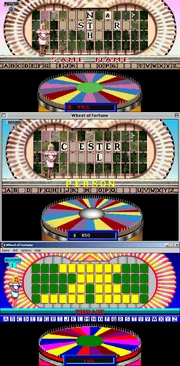
Comparison of the Wheel and puzzle board from the 1991 game for (from top to bottom) MS-DOS, Macintosh, and Windows.
The 1991 game was released for MS-DOS, Macintosh, and Windows, and was the first to use Prize wedges (using a small rotation of prizes in the main game and Bonus Round), and a three-round structure ($950/$2,500/$5,000). The Wheel layout is based off the one used in the show's 1989-92 intro (although in the Windows version, the values were completely randomized), making this version the first of only two to use $850 and $950 as playable values, the other being Scopely's Wheel of Fortune: Free Play (read below). Although a sole $350 was present in the intro layout, the game replaces it with a Bankrupt. Prizes were introduced in Round 2, although on the Macintosh and Windows versions they have no effect on the player's score. In all three platforms of this game, if the winning player is human, s/he has the option not to participate in the Bonus Round.
The available Bonus Round prizes are as follows:
- Annuity ($30,000), Asia Trip ($18,000), Diamond Earrings ($19,000), Diamond Necklace ($24,200), Family Car ($16,800), London Holiday ($20,000), Luxury Sedan ($34,900), Mink Coat ($16,400), Motorhome ($44,000), Oriental Carpet ($19,000), Original Art ($21,000), Paris Holiday ($19,000), Sailboat ($39,000), Shopping Spree ($23,000), Ski Boat ($17,300), Sports Car ($23,500), World Cruise ($45,000), $25,000
In 1993, GameTek re-released the Macintosh version on CD-ROM, making it the first Wheel of Fortune game to be released on such a medium. This re-release was also the first Wheel of Fortune game to receive a rating from the Entertainment Software Rating Board (ESRB), K-A for "Kids to Adults" in this case.
The 1994 Deluxe Edition has overall visual and Wheel layout structure similarities to its SNES counterpart. Although $350 is present this time, there is one space in round 3 (between the $250 and $900) that is "valued" at that, but the game recognizes it as a $300 space. Another difference to the SNES version is that prize wedges, including the Surprise and even one that offers cash, are present. Interestingly, one of the screenshots on the boxart's back has a digitized screenshot heavily resembling the January 1991 NBC daytime opening, albeit with the Season 10 backdrops; while it is not from the MS-DOS version (as it and the Windows version are exactly the same), it is likely from an in-progress build. The 1996 remake for Windows 95 is believed to be rare, but graphically similar yet improved to its 1994 brethren.
Along with these, GameTek reissued the Sharedata games with more uniform boxes, followed by the three in a box set in 1992 (although the box itself says 1990, the discs are dated 1992). The box of the three-in-one set lists the categories of Clue, Same Name, Place, Thing, Person, Two of the Same, Song Title, Employement (sic), and Star & Role; most were not actually in the Sharedata games, while Song Title was not used on the show until Season 23 and "Employement" is likely Occupation. Two of the Same is an oddity, and its purpose is unknown.
NES (1987-1990, 1992)
Rare designed the first three releases for the Nintendo Entertainment System in September 1987, October 1989 (Junior Edition), and March 1990 (Family Edition). Puzzles and prizes on Junior and Family are appropriate, while both retain the five-and-a-vowel Bonus Round. Further, Family omits "Changing Keys" and always spells out AND in Same Name. Also, some Same Name puzzles have three names instead of two. All four NES games, however, are the first electronic adaptions to allow for unlimited guesses within a certain time limit (60 seconds in all of these cases).
The first three games use the same engine: three rounds are played with a single Wheel template (which is the same as the 1986 nighttime round 1 layout albeit with the sole $450 decreased to $400, despite the former being an "unused" value as stated below) with Round 3 beginning as a Speed-Up. Bankrupt is seen as "B00", Lose A Turn as "M00" (for Miss A Turn; known simply as Miss Turn in the game), and Free Spin as "+00". A fan rendition of the Wheel itself can be seen here.
There are quite a few oddities about Rare's versions:
- The original game (as well as the original Jeopardy!) has a pair of unused Coca-Cola logos among the sprites, as Merv Griffin Enterprises was owned by Coca-Cola during the games' development in 1987.
- There are quite a few unused Wheel values in at least the original game: $450, $550, $650, $850, $900, $950, $1,050, every $x,000 value from $2,000-$10,000, and a duplicate $1,000.
- For unknown reasons, the PRG1 revision of the original game replaces the puzzle I CAN'T GET NO RELIEF (a lyric from "All Along the Watchtower", written and originally recorded by Bob Dylan) with I DON'T GET NO RESPECT (Rodney Dangerfield's catchphrase).
- On the back of the original game's instruction booklet are "coming soon" advertisements and box art for NES versions of The Price Is Right and Password, the latter using a screencap from the 1980s Pyramid. Neither was released, with Password becoming Super Password and finally Talking Super Password (with box art released for both plus two screenshots of gameplay) before being shelved.
- The Junior Edition box art shows a layout with two Lose A Turn wedges and two $550s (one being the customary purple, the other being green).
- All three instruction booklets state that hitting Miss A Turn causes that player to lose their next turn as well, a penalty which does not actually occur in any game.
- The categories in the original game are Event, Landmark, Person/People, Phrase, Place, Thing(s), and Title; Junior Edition replaces Landmark with Fictional Character(s), and Family Edition replaces Fictional Characters with Same Name.
- All three versions consider Fictional Characters, People, and Things to be separate categories, although Fictional Character is shortened to "Fiction Person".
- If a player has less than $250 when there are only vowels left in the puzzle, s/he is out of the round. If all three players have less than $250, the puzzle is discarded and the round is restarted.
- While there is a "correct letter" sound present, during the front game a short piece of music plays instead of the first five "ding" sounds. Of the approximately 3,000 puzzles in the three games, only 38 actually have six or more instances of a letter: 14 in the original, six in Junior Edition, and 18 in Family Edition. Of those, only three (IT'S THE NEXT BEST THING TO BEING THERE and NOW THAT THE SHOE IS ON THE OTHER FOOT in the original game, NINA PINTA AND SANTA MARIA in Junior Edition) play the sound multiple times. The sound is used normally in the Bonus Round of the first two games, whereas Family Edition plays music throughout the Bonus Round.
- There are only two puzzles with eight of the same letter in them: FINDERS KEEPERS LOSERS WEEPERS in Junior Edition, BARBARA AND JOHANN SEBASTIAN BACH in Family Edition.
- If a puzzle has punctuation, it is presented with the punctuation already turned over.
- If a computer player wins the game, the Bonus Round is played (the first games to have such a feature).
- A Wheel reference is in Rare's 1988 NES game Taboo: The Sixth Sense – each card type has its own music if drawn, and "The Wheel of Fortune" uses a few seconds of "Changing Keys".
Wheel of Fortune featuring Vanna White, developed by IJE (also responsible for Talking Super Jeopardy!), was released in January 1992 and uses a new set of graphics, music, and sound effects. It is also the first Wheel game to let the player choose an avatar, the first to use the three-and-a-vowel Bonus Round, and the first to use the W-H-E-E-L envelopes; in the event the Bonus Round is lost, the prize appears and then fades away pixel by pixel. This version uses the same categories as Family Edition, but adds Before & After. A review of the game can be found here.
This version is the first console adaption to use all the layouts that were in use on the show at the time of its release. The only differences are that the layouts are reversed and the $500 by the Lose A Turn (known as 'Lose Turn' in the game, albeit with no space) is still worth $150. Also, the $400 by the $900 is halved to $200 and is the location of the Free Spin in Round 1. In Round 2, a Free Spin token is placed on the $200 between the $500 and $300 regardless of whether or not it was claimed in Round 1, although the first Free Spin is still removed if it was not landed on in Round 1. In both rounds, players who land on Free Spin are promptly awarded a Free Spin token and play for $200 (the only game to feature this rule). As with 'Lose Turn', there is no space between the words Free Spin.
Instead of a bar, the strength indicator is a set of colored lights below the Wheel. When the Wheel is spun, the light that is lit determines how long the Wheel spins. From weakest to strongest, the lights are colored blue, green, red, and white, although all would be white as the Wheel spins. The contestant avatars clap while the wheel is spinning and smile when landing on a dollar amount, show a look of shock then smile when landing on Free Spin, and frown upon hitting a penalty space. If there is more than one instance of a letter appearing in a puzzle, they light up all at once.
Unlike its computer counterparts, the NES version has speech of Vanna, albeit only once: if the Bonus Round is won, she says "Congratulations!"
The available Bonus Round prizes in the four games are as follows:
- Original: Porsche, Speedboat, Deluxe Kitchen, Ski Holiday, Luxury Bedroom, Hawaiian Vacation.
- Junior: Stereo System, 10-Speed Bicycles, TV and VCR, Disney World Vacation, $1,000 Shopping Spree, Washington DC Holiday.
- Family: Emerald Necklace, Caribbean Cruise, Beach House, April in Paris Vacation, Concorde to London, Bentley.
- Starring Vanna White: Car ($32,495), Boat ($29,998), Jewelry ($23,750), Cruise ($21,599), $25,000.
Arcade (1988)
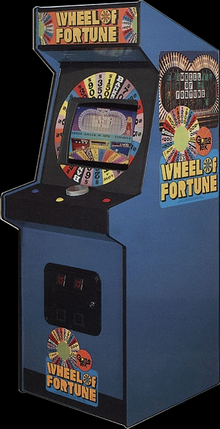
A video redemption game was released in July 1988, with a single Wheel template (based on the nighttime 1986 Round 1 layout, with values in $100 increments; top dollar is $900, although vowels still cost $250). Players are given a set number of "misses" before gameplay ends, but can receive an extra turn by hitting certain scores and solving puzzles (which also award a $10,000 bonus). There is no Free Spin, Speed-Up, or Bonus Round, but the Vanna look-alike switches color dresses and shoes in each round (red in odd-numbered rounds, blue in even-numbered ones).
This was the first version to let the player physically spin the Wheel, by way of an encoder wheel also used to select letters and game options. This was also the first electronic adaption to have Lose A Turn's actual name displayed in-game. The bezel, marquee, and side artwork all show the entire 1986 Round 3/1987 Round 4 template (with Bookman ITC Bold font instead of the standard font) and puzzle board with title.
The official flyer also mentions countertop and cocktail table versions.
Game Boy (1990)
Released in September 1990 and apparently based on Pressman's Junior Edition board game as well as the nighttime 1986 round one layout: the Wheel has values in multiples of $100 (by subtracting $50 from all the $X50 values although vowels are still $250), with a top value of $1,000 in Rounds 1-2. In round 2, the $100 space between the Bankrupt and Miss Turn spaces is increased to $500. In round 3, the Speed-Up, the same space is increased to $5,000. The Bonus Round, still using the five-and-a-vowel rule, is played for $25,000, a boat, a cruise, a trip, or a car.
SNES (1992, 1994)
Two versions were released in September 1992 and April 1994 (Deluxe Edition) for the Super Nintendo Entertainment System, based on the W-H-E-E-L format first used in September 1989. The 1992 edition uses the round 4 layout used on the show at the time (with Free Spins placed on a $300 or $500 space) with some oddities. One, the $5,000 space is a white $600 in round one, which is replaced by a white $2,500 for rounds 2 and 3. The $400 is replaced by $5,000 in round 3, still retaining its red-orange color. In the Bonus Round, the prize is only revealed if the bonus puzzle is solved. Also, the player only gets one guess at the bonus puzzle.
Deluxe Edition uses the 1992 set, new contestant avatars, and a permanent Speed-Up as Round 5, although the full Wheel shot is replaced by a simple animation.
There are several oddities about Deluxe Edition:
- Although the game uses the show's $1,000/$2,500/$3,500/$5,000 top dollar value formats (with the layouts reversed), the instruction booklet incorrectly states that $1,500 is added to the Wheel in Round 2 and that $2,500 is added in Round 3. The booklet also implies that Free Spins can be used in every round except the Bonus Round, but they cannot be used in the Speed-Up Round either. This may be because much of the wording was recycled from the 1992 version's instruction booklet.
- Round 2 uses the barren Round 3 layout with $2,500 in place of the $1,000 (and $300 in the place of $3,500), while Round 3 uses the Round 4 layout swapping the $1,500 and $700 (the latter of which is valued at $3,500 in Round 3) on each side of one Bankrupt. The $5,000 space is valued at $250 in Round 3.
- The $250 space next to Lose Turn is decreased to $200 in Round 2.
- Rounds 1 through 4 start with a Free Spin on the Wheel, regardless of whether or not it is picked up the round prior. Also, the value under the Free Spin is always $150, although this is not added to one's score unlike the original and Genesis versions.
- Vowels award money in the Speed-Up.
- The absence of $350 is shown in two ways: in Round 1, it is replaced by the usual $300, as is the case for the one next to Lose Turn in Rounds 3-4. The other $350 in Rounds 3-4, however, is replaced by $250. The original and Genesis adaptions do use $350.
- Contestants have a time limit in which to choose their letters in the Bonus Round, a trait shared by its 1994 PC counterpart along with several other console versions at the time.
If a Person is a proper name, it will say so. Also, there is a Family puzzle mentioning a specific family rather than of individual members (THE DIONNE QUINTUPLETS), which is not known to have been done on the show until 2006.
Unlike the 1992 edition, if the Bonus Round is lost on the Deluxe Edition, Vanna will go and turn over the rest of the letters in puzzle and the prize that you could've won is revealed.
The Bonus Round prizes are a necklace (renamed jewellery [sic] in the Genesis version), a speedboat, a sports car, a vacation, and $25,000.
In both games, the end credits are displayed against an image of the set from October 5, 1987 (the first Big Month of Cash episode), complete with the original $25,000 sign.
Sega Genesis (1992)
The Genesis version was a simultaneous release with the SNES one. Barring some minor audiovisual differences due to the respective console limitations (most notably the Wheel itself), they are exactly the same. Like the 1992 SNES version, the Genesis uses only the Round 4 layout, only reversed and with one Bankrupt. The other Bankrupt is replaced by $200 and, instead of being placed between $700 and $1,500, is placed between $250 and $300. Additionally, $5,000 is decreased to $250. Unlike the 1992 SNES version, the $2,500 (introduced in Round 2) and $5,000 (introduced in Round 3) spaces do not have one possible placement. Rather, the $2,500 space can be placed on any of the $200 spaces while the $5,000 can be placed on any of the $250 spaces (including the one mentioned above). This means that in some games, the $2,500 and $5,000 can be adjacent to one another.
Free Spins are always placed on a $250, $400, or $800 space. If one is picked up from a $250, another Free Spin is placed on a different $250 space at the beginning of the next round. If one is picked up from the $400 or $800 space, another is placed on the same space at the beginning of the next round.
Another difference was when an avatar showed an expression of joy upon landing on a large dollar amount or solving the puzzle. On the Genesis version, the avatar smiles when the dollar amount landed on is $500 or higher, compared to $800 or higher on the 1992 SNES version. The avatar frowns if Lose a Turn or Bankrupt is hit.
The only oddity about this adaption is that the instruction booklet stated that the Lose A Turn was Miss A Turn, stating that the player loses/misses his/her next turn. In the game, however, it is simply referred to as Lose Turn, and the player does not miss the following turn.
The 1992 CES ad sheet promoting this version has a picture of the then-used Round 4 layout with a few differences: the dollar signs are most likely in Book Antiqua font, while the numbers and Lose A Turn are in Bookman ITC (the Bankrupts are still in their normal appearance). $700 is pink, while $600 is purple. The pink $350 is decreased to $300, and the space next to it is a gold $5,000 rather than a yellow $1,500.
Just like the SNES versions, the end credits for the Sega Genesis version are also displayed against the same image of the set from October 5, 1987 (the first Big Month of Cash episode) with the original $25,000 sign.
Game Gear (1992)
A unique version for Sega's portable system, featuring Vanna White and a futuristic atmosphere; while the full set is never seen, a fan took the various elements and made this approximation. This Wheel in a rainbow-colored scheme has just 16 spaces and 12 unique dollar values: the Round 1 layout, going clockwise, is Bankrupt-$550-$200-$350-$300-$750-$450-$900-Lose Turn-$700-$650-$500. $500 is replaced by $2,500 for Round 2, which in turn is replaced by $5,000 in Round 3. Lose Turn and Free Spin are, again, each displayed as one word.
The values are displayed in a small rectangle below the Wheel. The font of the value displayed, however, is different in the screenshots shown in the instruction booklet as well as the back of the boxart, suggesting that they were from a work in progress. One of the instruction booklet's screenshots is flipped horizontally showing the rectangle at the top left instead of the the bottom left.
One major problem with this version is that Free Spins are sometimes placed on either the Lose A Turn or the Bankrupt, which only results in a penalty. In addition, the words Free Spin appear sporadically and only when the Wheel comes to a stop.
Although frowning sprites were made, they were ultimately unused. As an odd result, the character smiles even after landing on a penalty wedge.
This version uses the same exact puzzles & categories as the Sega Genesis version (except for "Star and Role").
The box art of this version is the same as the Genesis one, albeit using Bookman ITC Bold instead of the Wheel's standard font.
When the Bonus Round is won, the prize is displayed on a TV monitor with Vanna gesturing towards it.
Like the 1991 games for the PC, no speech of Vanna exists.
The Bonus Round prizes consist of the following, and is to date the only game where the Bonus Round prizes are each assigned to a letter rather than randomly distributed:
- W: $25,000
- H: Speedboat
- E #1: Car
- E #2: US Savings Bonds
- L: Vacation
Nintendo 64 (1997)
By 1997, GameTek was rapidly losing money and had no choice but to file for bankruptcy; their final Wheel game was released on December 2 of that year. It is the first version to use the $10,000 Wedge, Jackpot Round, touch-screen puzzle board, and 1994 theme song; it is also the last to use the multi-template Wheel, as well as the last to use the ESRB's K-A rating. You can read more about it here, and read some FAQ's here. The developmental stages of the game can be seen here.
This version has some oddities, possibly a result of the company's financial problems:
- An arcade-style demonstration of Round 3 starts (lasting for about 30 seconds) if the Start button is not pressed at the intro screen.
- Although the Jackpot premiered the same day the multi-template system became a single-template system on the show, the old multi-template system is still present in the game along with the Jackpot.
- The video clips with Vanna use a cropped screenshot of the game in its development stage in the background. Additionally, this is the first version to feature Vanna sporting short hair.
- Like in both of Sony Imagesoft's adaptions, Vanna simply walks from one side of the board to the other without revealing the letters manually although the letters reveal when she passes by. She still does this in the Bonus Round even if none of RSTLNE or the additional letters chosen are in the puzzle.
- Despite being seen in the instruction booklet as well as a developmental layout, the Surprise wedge is ultimately not used.
- The purple $200 seen in the instruction booklet's layout is displayed as "$000", and is so far the only instance of such. Additionally, the red $200 and adjacent yellow $500 swap colors.
- If a player tries to buy a vowel with less than $250, s/he automatically loses their turn. In addition, while the "Only Vowels Left" beeps remain, there is nothing to indicate if there are no vowels remaining in the puzzle.
- Free Spin is only present in Round 3, seen on the orange $200.
- The Jackpot wedge replaces the pink $200, and the adjacent $400 is teal, likely to avoid two wedges of the same color (as seen on the photo on the back of the box and in the instruction booklet).
- If the $10,000 Wedge is hit in the Jackpot Round, $10,000 is added to the Jackpot whether the wedge is claimed or not; if hit in the Speed-Up Round, the Wheel must be spun again.
- The arrow used to determine the Speed-Up value is that of the player in control when the Speed-Up starts, exactly like on Australia's version.
- The Bonus Round is played for $25,000, and the player has 20 seconds to solve the puzzle. If won, there is a flashing "$25,000" graphic accompanied by the Jackpot win fireworks. In addition, if the vowel is not selected last, it still shows up in its proper position as if it were selected last (far right). However, like many other electronic adaptions, if the front game winner is a computer player, no Bonus Round is played, and the game ends.
The template changes are as follows:
- Round 1: The purple $200 is $300, $450 is $400, the red-orange $350 becomes a red $300, and the purple $250 next to it is pink.
- Round 2: Same as before, except $150 is increased to $800, the purple $300 is increased to $550, and the tan $200 near Lose A Turn is increased to a purple $350.
- Round 3: As noted above, Free Spin is on the orange $200, the Jackpot wedge replaces the pink $200, while the adjacent $400 is teal. In addition, $150 is a pink $300.
- Rounds 4+: The red-orange $400 is red while the $250 between $5,000 and Lose A Turn is red-orange as opposed to red.
The intro is styled like the ones used in Seasons 12-14, and the graphic used is the game's Round 1 template with a gold $10,000 wedge replacing the sparkly-green $1,000, a red $350 in place of the $300 by the Bankrupt and a red $450 in place of the $400 by the Lose A Turn. The studio portion of the intro is similar to that of Season 14, and uses the Round 1 template in the game itself in the circular concrete center; in addition, the music starts at the opening bars and fades before reaching the main melody. The box art uses the then-new puzzle board with title, Vanna, and the barely-seen Wheel with 1996 Round 1 template in the background. The set is from New York week (May 26-30), as shown on the video wall behind Vanna, suggesting the game was in development at that time. The box's back and sides use the 1994 version of the two-row logo (i.e., the U's bottom is flat and the "O" in "of" is normal-looking instead of the traditional Wheel shape), with the same artwork as the front.
Mattel (1988)
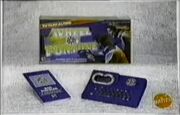
An electronic handheld game allowing players to play puzzles from the unit, or receive "invisible signals" from the TV show and play along with those puzzles (a March 1988 Variety article states that the interactive element would debut that Fall).
The game, which initially sold for $79.99, contains the unit and a booklet with 240 puzzles, 40 of which are for younger players. Two numbered VHS tapes, sold separately, contain another 90 puzzles each. The back of the box shows the partially-filled puzzle IN THE IMMORTAL WORDS OF (Phrase); as it appears on both the picture demonstrating the play-along aspect and that demonstrating the tapes, it is not certain whether the puzzle was actually used on the show.
The Mattel game was first promoted in the replacement fee plugs in mid-1988, after Jack Clark became too ill to do them. These plugs, the box itself, and a sticker on the back of the unit all state that only the nighttime show is compatible; the box and unit specifically mention August 31, 1988 through "at least" September 1, 1990, which would mean that Seasons 5-7 were compatible. Owners of the device have reported that it still worked on GSN reruns of Season 6.
The unit itself contains a QWERTY keyboard that has consonants colored in black and vowels colored in white.
A review of the item can be found here and here, and clips of the VHS tapes can be found here and here.
Lazer-Tron (1992)
A unique ticket-redemption game called Spin to Win which was not licensed, but clearly influenced: the player rolls three balls, one at a time, down into one of seven slots which determine the Wheel's movement (normally Bankrupt, 1 Slot Right, 3 Slots Left, No Spin, 3 Slots Right, 1 Slot Left, and Full Spin). If Bankrupt was hit, the wheel would spin until it stopped at the nearest Bankrupt.
The 15-wedge Wheel has values ranging from 1-15 (sometimes 20) tickets along with two Bankrupts, Lose A Ball, Double Ticket Bank, and Bonus Jackpot. The jackpot is awarded by landing on Bonus Jackpot for the third turn, then landing on it again at the end of the following game.
A demo of the game can be found here.
Sony Imagesoft (1994)
Released a version for the Sega CD in April 1994, with a PC version following in June, the second Wheel game released for CD-ROM after GameTek's 1991 game for the Macintosh. The Sega CD version uses full-motion video and high-quality audio of the 1989 music package (hence the copies that circulate today) with the 1992 intro and set. The PC version uses the 1992 music with Season 11 intro and 1994 set. Despite it taking over production in the fall of that same year, the copyright date acknowledges Columbia-TriStar Television.
The Sega CD version (which noticeably emulated the show quite well) is the second to use Prize wedges (after the Vanna White edition for PC platforms in 1991) but the first console adaption to have the Surprise wedge: a trip (a $3,500 ocean cruise) is added in Round 2, followed by jewelry (a $3,000 bracelet) in Round 4; Surprise is present throughout (and its letter outlines are yellow in Round 1 and red in subsequent rounds). Also, there are no warnings as to when all the vowels in the puzzle have been chosen. The Bonus Round is played much like on the show, with five envelopes that decrease if the bonus puzzle is solved (the only game to have this feature as well as the only console version to have a returning champion's format). Also, it is the only game of the two in which Vanna verbally tells the players if letters are or are not in the puzzle, when the Speed-Up Round begins, etc.; in addition, the player If a player missolves, miscalls (either by choosing a vowel after spinning or choosing a letter already been chosen), or hits a penalty space, she is seen using an expression of frustration with her fist going down then upwards. Unlike most other games, the Bankrupt slide whistle does not sound immediately after the Wheel has landed on its namesake space; it is delayed until after Vanna has told the player that they hit Bankrupt. If a male player wins the round/leads the game, the closing variant of the 1989 theme plays; if the winner/leader is a female, the theme starts from a later point. Instead of the double-buzz from the show, the wrong-letter buzzer sounds when a player fails to successfully solve the Bonus Round puzzle before time has expired.
When won, the Surprise is one of four Prizes.
- Grand Piano ($5,300)
- His & Her Watches ($2,000)
- Jet Ski ($2,200)
- Pearl Necklace ($1,200)
Among the biggest oddities of the Sega CD version, however, is that upon using the Free Spin (which is always placed on the orange $400 near Lose A Turn in the first two rounds), the player is immediately taken back to the Wheel, forcing him/her to spin again. Also, there are always 4 rounds, even if there's no Speed-Up, which, should it occur, always occurs in Round 4. That means either way, there is a definite end to the front game. In addition, Vanna states that a new Prize is added to the Wheel at the start of Rounds 2, 3, and 4, but no new Prizes are added in Round 3. Finally, like in some earlier electronic adaptions, contestants are allowed only one guess at the solution in the Bonus Round within 45 seconds.
The Bonus Round Prizes are as follows.
- A Diamond Ring ($30,000)
- A New Car ($35,000)
- A Trip to the Caribbean ($20,000)
- Savings Bond ($20,000)
- $25,000
The PC version had no prize wedges whatsoever, but still awarded $200 as a "house minimum". $2,500 is pink (as seen on the screenshots) instead of blue, while $3,500 is red instead of magenta. The Free Spin is seen on the red $200 in Round 1, only to be moved to the orange $200 next to the pink $2,500 in Round 2. The Bonus Round is only played when a human player wins the game, but instead of choosing envelopes, the player plays for $25,000; if an incorrect guess is made, Vanna will allow the player to try again if he or she so chooses. Also, all dollar values are announced by video of Vanna with the exception of $350, possibly due to memory limits (although she does announce this value and all other values by audio in the Sega CD version); in addition, all values that end in -50 are announced as "# and 50 dollars", instead of "#50" as in later games (and on the show).
Unlike the Sega CD version, Vanna does give a warning as to when all the vowels have been purchased; this is also indicated by the darkening of any remaining vowels on the Used Letter Board. In addition, this is the only game that allows the user to set all three players to AI (computer) to let the game play itself, the main game can be played up to six rounds, and the time limits can be set at either 25 or 30 seconds or no time limit; however, this does not stop the game from going into Speed-Up mode nor does it prevent a time limit on choosing what to do when it's a player's turn, a general rule is that a player has 15 seconds to either spin, buy, or solve.
[Note: The game uses Version 2.1 of Apple's QuickTime Player (which is included in the game), so the game must be installed first before upgrading/updating the QuickTime Player. However, installing the newer Player does not automatically remove the older Player(s); so it is automatically assumed that the older Player(s) is/are necessary to play the game. It should be noted that not all OS's are compatible; the following Windows systems are compatible: 3.1, 95, 98, ME, NT, XP.]
Both games also allow the user to play a game with less than three players, regardless of each player's mode.
The artwork on both versions features Vanna in front of the blue contestant "interlocking W" backdrop, with the PC version also showing the Season 12 puzzle board. The logo is the traditional one with colors inside the "wedges". The back of the boxes consist of a red two-row logo, with each wedge in a triangular shape; however, the CD case has the "colored wedge" traditional logo on the back, plus two screenshots: the top shows the Wheel in mid-spin from the Sega CD game, while the bottom shows Vanna in the PC game.
In the Sega CD game, each player's flipper is used during their respective turn (1-red, 2-yellow, 3-blue); however, the lights do not flash as the Wheel spins. Plus, the towers are seen in their respective colors. Additionally, the arrows (although one is shown at a time) are positioned as if the podiums were positioned just like the ones on the show (the first Wheel game to offer such a feature). In addition, the Wheel must make one complete revolution for a spin to count, exactly like the rules of the Wheel used in the Showcase Showdown on The Price is Right.
In the PC game, only the yellow flipper is used and the lights do flash as the Wheel spins. Plus, the towers are all white. The player can control the Wheel's momentum either by clicking in the bar which automatically controls the spin, or control it manually by pressing the space bar to the desire momentum and pressing Enter/Return.
The Sega CD game has 5,590 puzzles in 35 categories, with plurals considered separate: Artist/Song, Before & After, Event(s), Family, Fictional Character(s), Fictional Place, Foreign Phrase, Foreign Words, Husband & Wife, Landmark, Nickname, Occupation, Person/People, Person/Title, Phrase, Place(s), Quotation, Same Name, Slang, Star & Role, The Twenties, The Thirties, The Forties, The Fifties, The Sixties, The Seventies, The Eighties, Thing(s), Title, and Title/Author. Some puzzles are clearly taken from real ones used by the show.
- Another ten categories are clearly the result of typos, and have just one puzzle each: a Before & After with two spaces after the ampersand, Befor & After, Meabefore & After, Phase, Pole Phrase (with three spaces between the words), Quotaton, Same Nme, Star/Role, T Quotation (with four spaces), and an untitled category.
Funhouse (1995)
A non-video redemption game, this version involves lighting up the A, K, and O in JACKPOT by landing on a certain wedge of the 12-wedge Wheel. A light travels around the Wheel itself, and once a coin is inserted the light stops; the Wheel has values in tickets (2-12 by default, though values vary by arcade), a Bankrupt wedge awarding no tickets for that turn (previous winnings are not affected), and a "turn letter" wedge which reveals one of the missing letters and awards a large amount of tickets (50 by default), as seen here and here (30, as shown in this example). If JACKPOT is successfully filled in, the player wins an extra 100 tickets.
The front of the machine has a photo of the "road show" puzzle board (though duplicated and meshed with one another to fit the width of the machine), a photo of the Wheel with Rounds 4+ template partially blurred as if spinning (taken from the cover of the 1992 Tyco board game), and the logo spelled out all in one row with dots between the words similar to the traditional logo. A Vanna look-alike is placed to the left of the "puzzle". The side artwork features the same logo spelled out in one row across a graphic of the "rug" template.
Tiger Electronics (1995-2002)
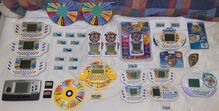
A fan's collection of Tiger's Wheel of Fortune games and cartridges. Note that Wheel of Fortune Live Play (read below in Canceled Versions) can be seen at the bottom right.
Tiger released four electronic handheld games, the second (1999), third (2000), and fourth (2001) being Deluxe Edition, Junior Edition, and Classic Edition, respectively. All four games had several expansion cartridges (with different puzzles on them to allow for a better variety), and use a three-round format. If there are only two players and the computer player is Player 2, Player 1 starts Round 3. However, if the computer player has the most money after Round 3, no Bonus Round is played and the game ends.
The Bonus Round on the 1995 and 1999 games uses the W-H-E-E-L format, but the pointer randomly chooses one of the spaces on the Wheel, and the prize is 10 times the amount the pointer is on. If the "E" is chosen, the unit will randomly choose one of the two. In addition, when choosing the three consonants and one vowel, consonants must be typed in first before the vowel, as typing the vowel automatically enables the Solve mode and the player can no longer refer back to the category. In both cases, the player has 40 seconds to solve the puzzle.
Original Edition
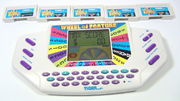
The 1995-96 game uses a 12-space Wheel with the following layout: $100-Bankrupt-$750-$2,500-$400-$500-Lose A Turn-$600-$5,000-$250-Free Spin-$300, with $2,500 active in Rounds 2 and 3, and $5,000 in Round 3 only (thus making all spaces active). If the Wheel stops on a 4-digit wedge in either or both of the first two rounds ($2,500 in Round 1, $5,000 in Rounds 1-2), the Wheel "clicks" over to the next active space ($400 and $250, respectively). Free Spin is spelled vertically unlike the wedge used from 1975-1989. Also unlike the show's Free Spin wedge, this wedge is available in all rounds, and when landed on, the player must call a letter to actually get the Free Spin. If successful, the wedge is inactive on the Wheel until the Free Spin is used, which must be done immediately after calling an incorrect letter, missolving the puzzle, or hitting Bankrupt or Lose A Turn (the latter two rarely occur while a player has a Free Spin). If the player solves the puzzle while still holding a Free Spin, it does not carry over into the next round and has to be re-earned. If a puzzle is solved with less than $250, the player's score is upgraded to that "house minimum". If a puzzle only has vowels remaining and the player tries to spin, a buzzer will sound and the Wheel will not spin. The QWERTY keyboard is color-coded to differentiate the letters, with consonants in purple and vowels in blue. The entire LCD display, including a 20-space puzzle board, can be seen here.
The artwork on the packaging includes a logo similar to that of Seasons 12-14, but with the Wheel-shaped O on the logo, and Bankrupt, a purple Lose A Turn, and a green Free Spin on the Wheel graphic itself (as seen here and here), all against a photo of an unrevealed road show puzzle board beneath a starfield background. The graphic for the expansion cartridges use Lose A Turn in its traditional yellow color, as seen here and here. The template for the logo is Bankrupt-$150-$500-$300-$200-$100-$500-$250-Free Spin-$800-$250-$350-$500-$150-$600-$150-$800-Lose A Turn-$350-$400-$200-$500-$150-$800.
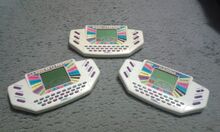
Tiger's American game (top) is shown with its French (left) and German (right) counterparts.
The game was marketed on the backs of specially-marked boxes of Kellogg's Corn Flakes cereal, which also had a mini-game which contained Corn Flakes-related puzzles that could be solved using a letter-by-number code to help out. In addition, the game was advertised in a commercial (alternate copy)that featured several kids who were so frustrated by their parents' constant playing of the game that they themselves pretended they were the parents of their own parents.
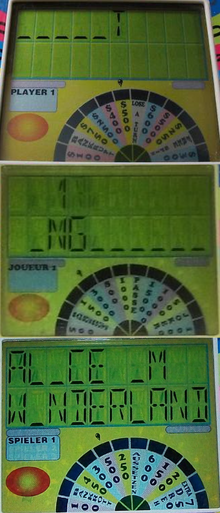
Comparisons of screens used in the (top to bottom) American, French, and German versions.
The game was marketed again in 1996 with the copyright date shown as such, and the packaging updated to move the logo over to cover all the concealed letters in the top row (leaving only the second and third rows visible), and "Over 400 Puzzles in 11 Categories" (as shown on the instruction booklet) instead of "Over 400 Puzzles in 9 Categories".
Tiger had also released the game in France in 1996 and Germany in 1997, underLa Roue de la Fortuneand Glücksradrespectively. In France's version, the packaging layouts had larger values and no dollar/franc symbols. The in-game layout was 500-Banqueroute-1,500-3,000-800-1,000-Passe-1,500-10,000-500-Joker-1,000 with 10,000 becoming active in Round 3. If the Wheel stops on 10,000 in the first two rounds, it will "click" over to the adjacent 500. Vowels cost 1,000 francs, but a bug takes away 10,000 if a player buys a vowel with a five-digit round score that has a zero as the thousands digit. In the Bonus Round, the winning player chooses from the letters E-T-A-P-E with the E chosen at random.
In Germany's version, the packaging layout was similar to the American packaging layout only without dollar signs/mark symbols but had two adjacent purple wedges (Aussetzen [Lose A Turn]/350). Germany's Wheel layout in the gameplay itself, however, was also different from the American one (100-Bankrott-450-300-500-250-Aussetzen-600-150-200-Extra Dreh-750; every space is active throughout the game) although vowels still cost 250. Also, unlike its American counterpart (yet like on both the American and German shows), the Wheel's Extra Dreh space was T-styled (Horizontal "Extra," Vertical "Dreh"). The Bonus Round sees the winning player choose from the letters R-U-N-D-E. Also by this time, the American game was repackaged in a box, complete with a bonus cartridge (normally sold separately).
The cartridges contain only puzzles and are region-free. This means an American cartridge will not only work on a French or German unit without any problems but will also display the categories and puzzles in English. Nevertheless, all the displays below the puzzle board will still show their native wording and Wheel values.
Game.com
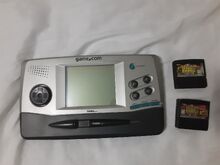
When Tiger attempted to enter the portable video game market with the Game.com, two versions of Wheel were released in 1997 and 1998; both contain 750 puzzles and are controlled by the touch screen, with the 1998 game titled Wheel of Fortune 2. With the exception of the slightly different intro screens, player avatars, and puzzles used, both games are exactly the same. The Wheel spun counterclockwise and its values were Bankrupt-$500-$400-$2,500-Lose A Turn-Free Spin-$300-$900-$250-$5,000-$750-$600 with $2,500 becoming active in Round 2 and $5,000 in Round 3. Before being introduced, $2,500 and $5,000 were valued ten times less although the numbers remained the same smaller size.
Slot Machine Game
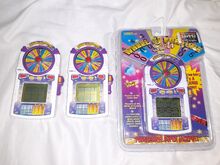
Three versions of Tiger's Wheel of Fortune Slots. The only difference between the two units at the left and center is the color of the "Super Jackpot!" wedges. The packaged copy at the right has the Wheel values in a different font.
Following the Game.com's failure, Tiger released an electronic handheld game based on International Gaming Technology's (IGT) Wheel slot machines. This game, titled Wheel of Fortune Slots, has a Super Jackpot which begins at $5,000 and increases by $1-$3 depending on the player's bet; the Jackpot is won by either landing on the "Super Jackpot!" wedge or getting three WOF symbols on the payout line with a $3 bet. The Wheel is spun when a SPIN symbol hits the payout line, offering an easy way to win the Super Jackpot or some value between $20 and $1,000. Winning combinations are not required to spin the Wheel.
The prototype's Wheel layout is the same as IGT's first slot machine layout (which had 22 wedges) only colored and styled like the packaging layout of Tiger's 1995 game and with a black "Super Jackpot!" wedge counterclockwise of the $1,000 space. The game was released with 24 wedges and many of the dollar values rearranged (and the inexplicable omission of $150) as a result. Later releases had the "Super Jackpot!" wedge colored red presumably so it would no longer resemble the Bankrupt wedge on the show. In late April 2021, a new-in-package copy was sold to a fan on eBay with the Wheel's dollar values in a monotype serif font.
Deluxe Edition
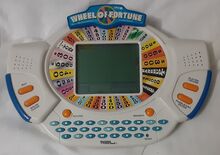
The Deluxe Edition game (1999) has the 1998 template and some special spaces: Free Spin, active in Rounds 1 and 2, is awarded the same way as the 1995 game and like before cannot be carried over to the next round and has to be re-earned (the space itself is the same blue $300 that occupies the token on the show; to accommodate, there is an orange $300 space next to it and a magenta $900 next to it after). Cash Bonus, active in Rounds 2 and 3, awards a cash bonus anywhere from $500-$3,000 in $500 increments if a correct consonant is chosen. Once hit, it becomes inactive for the rest of the round. As it was modeled after the Prize wedge's rules from 1983-1990, Cash Bonus worked the same way; it was won if the player who had it solved the puzzle without hitting a Bankrupt before (s)he did so. Jackpot, active in Round 3 only, awards $20,000 to the player's score if a correct consonant is called; this is a flat-rate cash prize, regardless of how many of that consonant appears and regardless of how many times it is landed on during the round. One of the two Bankrupts is active throughout with the second being added in Round 2. $1,000 is active only in Round 1. $2,500 and $10,000 are active only in Round 2. The $10,000 space is available until a correct letter is called when landed on, but the value is multiplied by the number of letter occurrences. $3,500 and $5,000 are active only in Round 3.
There are three different "house minimum" scores should a player solve the puzzle with less than that: $250 in Round 1, $500 in Round 2, and $750 in Round 3. The only "bonus" categories are Fill-In-The-Blank and Where Are We?, both identical to the show. In addition, there is a small lever at the top that can slide to the right to "spin" the Wheel.
Differences between the 1995 and 1999 games were the keyboard had all 26 letters of the alphabet in order instead of the QWERTY format, there was a Used Letter Board, and the puzzle board was much bigger. The package artwork of the game and expansion cartridges feature a colorful zoomed-up rendition of the 1998 Round 1 template, and the logos feature a capital O in "of" instead of the Wheel-shaped O or normal O in the 1994-97 logos.
The game's prototype layout (which can be seen on some packaging for the game's expansion cartridges) has several oddities as seen here. One, the $10,000 is colored pink and decreased to $1,000. Two, the light blue $2,500 space is doubled to $5,000. Three, the Cash Bonus is renamed Double Score. Four, the $350 right next to it is increased to a second $3,500. Five, the $5,000 is colored green and is valued at $50,000. Six, several values (including the Jackpot) have been shifted one space (by color and not value specifically), an aspect that the layout of the 2004 Live Play prototype (read below) would echo. The packaging layout is the same as the 1998 round 1 only with the purple and pink colors of the wedges on both sides of both $400 wedges swapped.
The game is compatible with cartridges from the 1995 game (as stated on the backside of the game's packaging), but it is not compatible with cartridges from the 2000 Jr. game or the 2002 Crossword game. It is presumed to not be compatible with the cartridge from the 2001 Classic game either.
Wheel of Fortune Jr.
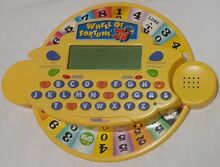
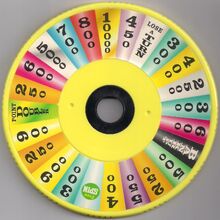
In 2000, Tiger released a version for kids which somewhat resembles Wheel 2000. The Wheel (seen at below right) offers points and was the first of Tiger's games which lets players physically spin the Wheel. The Wheel's layout is based off of the Season 16 layout only with some spaces moved around and/or increased.
Bankrupt and Lose A Turn work the same way as on the show, although the former was named either Bust or Busted on the game's prototype.
Free Spin worked somewhat differently than in the other games. If the player landed on it, s/he would immediately receive a Free Spin and then chose a letter for zero points. As with Tiger's other games, it would be used when a player chose an incorrect letter and would be surrendered when, if unused, would be surrendered at the end of the round it was obtained. It would be lost, however, when the player landed on a penalty wedge.
Landing on Point Doubler prompted the player to spin again, and whatever point value was landed on was doubled. Should Point Doubler be landed on again, the player simply spun again until something else was landed on. If Free Spin or a penalty wedge was landed on, the Point Doubler was void.
The top three values, used in all rounds, are 2,500/5,000/10,000. The winner plays for up to an additional 100,000 points in the Bonus Round.
The categories in the game are different from both Wheel 2000 and the adult Wheel, except Around the House and On The Map, which are categories on the latter.
- Around The House: An item normally used in an average household.
- Blast From The Past: Historical people or events.
- Book Club: Same as Book Title.
- Critters: Animals that are mammals, reptiles, birds, or insects.
- Down To a Science: Something related to the scientific community.
- I'm Hungry: Same as Food & Drink.
- It's My Job: Same as Occupation.
- Movies TV and 'Toons: Kids' movies or television programs, or a movie or show that kids know much about.
- On The Map: A city, continent, country, state, province, or body of water.
- School's Cool: Something related to school.
- Toy Chest: A toy product.
Interestingly, while 350 was not a point value in the game, it was present at the bottom of the game's packaging. The back of the game's packaging states that additional cartridges were sold separately, but although three additional cartridges are pictured, there is no evidence that they were released. Nevertheless, despite not being mentioned on the packaging, the game is compatible with cartridges from the 1995 game but not from the 1999 Deluxe game. In addition, neither the cartridge from this game nor those from the Deluxe game will fit in the 1995 game's cartridge slot.
Classic Edition
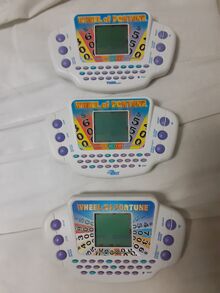
From top to bottom: Tiger's 2001 Classic Edition, the 2002 20th Anniversary Edition, and Parker Brothers' 2005 Second Edition
Released in 2001, re-released in 2002 as the 20th Anniversary Edition, and re-released again as a Second Edition by Parker Brothers in 2005, the rules (viewable here) are nearly identical to the Deluxe Edition, with the following differences:
- The button layout is the same as Tiger's first game from 1995.
- There is no Wheel label that determines what value has been landed on, despite colored spaces at the screen's border. Instead, the value spun is displayed via the puzzle board. Furthermore, the values of the spaces spun can shift on some spins (particularly when the dot makes a last-moment click to another space after the value spun is displayed), making for perhaps one of the two most random Wheels in any home adaptation of the show, the other being the 1991 Windows version.
- Once all consonants in the puzzle have been revealed, the screen will display "ONLY VOWELS LEFT IN PUZZLE". Likewise, once all vowels in the puzzle have been revealed, the screen will display "NO VOWELS LEFT IN PUZZLE".
- In Rounds 1-2, if the player landing on Free Spin claims it, the screen displays "YOU WON A FREE SPIN".
- The $10,000 cash prize is active in Round 3 only, and once a player claims it it is inactive for the rest of the round.
- The house minimum is $500.
- In the event of a tie between two or more players at the end of Round 3, a Speed-Up Round similar to the show's will be played; however, $250 is still deducted when a player calls a vowel (thus allowing them to actually be "bought" in the Speed-Up). If a player attempts to solve and misses, play immediately moves to the next player.
- The Bonus Round is played similar to the show, although all the prizes are cash. The amount being played for is revealed at the end of the round regardless of outcome.
- The 2001 game's keypad uses the QWERTY format like the 1995 game while both re-releases have the keypad alphabetized like the 1999 and 2000 games.
- The game is compatible with the cartridges from both the Original and Deluxe Edition games, but as with the 2000 Jr. game, only one cartridge was released for this edition. The 2002 and 2005 re-releases do not have a cartridge slot.
- The possible Bonus Round prizes in these games as well as all of Tiger's subsequent games (including Wheel of Fortune Live Play) are $10,000, $15,000, $20,000, and $25,000.
The label used on the 2001 and 2002 releases depict a close-up view of a recreation of the barren Round 4 Wheel used on the show at the time while the one on the 2005 game depicts a more full-on shot. The prototype's label uses colored wedges from the 1999 Deluxe Edition.
Wheel of Fortune Travel Game/Wheel of Fortune Pocket Game

The Travel game (packaged at left) alongside the Pocket Game (right)
In 2001, Tiger released a non-audio, oval-shaped game that doubled as a keychain, with a graphic of the Wheel serving as a protective cover. The gameplay is just like the show only there are two players as opposed to three (one human playing against one computer opponent). Some of the playable values were ones that have long been retired from the show such as $750 and even $2,000, making this one of only two home adaptions to offer the latter as a playable value, the other being Scopely's Wheel of Fortune: Free Play.
The possible Wheel values throughout all three rounds of the game are Bankrupt, Lose A Turn, Free Spin, $300, $400, $500, $600, $750, $1,000, and $2,000. $2,500 is available in the latter two rounds while $5,000 is available only in Round 3. Although Free Spins are still surrendered after a round ends like in Tiger's previous adaptions, after a Free Spin is used, it can be offered again later in the same round. Like in other Tiger games, when a player is in possession of the Free Spin, it's extremely rare if not impossible for a player to spin up a penalty wedge. Even so, when a Free Spin is used, the player is forced to spin again. In addition, if the player is in possession of a Free Spin yet makes an incorrect attempt at solving, he or she still loses his or her turn.
In 2003, Hasbro restyled the 2001 game in a unique ergonomic shape, getting rid of the keychain function, and released it as a pocket game. The gameplay is otherwise the exact same as the keychain version.
Wheel of Fortune Crossword
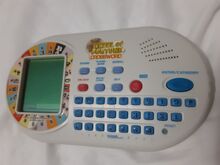
A crossword version released in 2002. The game consists of a 10×10 puzzle board with three words arranged in a crossword-type fashion. The game has two modes: Beginner (all three words are in the same category) and Advanced (the three words are in different categories). The game has three rounds and a Bonus Round, a total of 12 words.
If a word is solved, that player's score is temporarily saved, and whoever banks the most money after three words gets to keep it while their opponents' scores are reset to $0 (although as always, any previous rounds' "banked" winnings are never at stake). Although there is no house minimum, solving a word with no money awards $500. The 28-wedge Wheel has top values of $2,500 in Round 1 and $3,500 in Rounds 2-3. Round 3 also has a $10,000 Wedge which can only be awarded once (although it's still multiplied), usually becoming a $300 space afterwards.
The Bonus Round gives RSTLNE by default, after which the player chooses five consonants and two vowels. Solving all three words awards a cash bonus of up to $25,000.
As with the 2000 Jr. game and the 2001 Classic game, only one cartridge was known to have been released for the Crossword game. No cartridges from any other of the games will fit into this game's cartridge slot.
In addition to the fact that only one cartridge was released for Jr., Classic, and Crossword, these cartridges were unnumbered and had no warning label stating against removing the cartridge while the game was turned on. This meant that there were no puzzles on these cartridges and merely act as protection from dust. This is also the case for the unnumbered cartridges for the 1995 and 1999 games since every game, whether they support cartridges or not, have puzzles built in.
Hasbro Interactive (1998-2001)
Released two versions for the Sony PlayStation (PS1) on June 5, 1998 and October 18, 2000, plus two PC editions on September 30, 1998 and September 19, 2000 (a version for Macintosh computers was released in September 2001). The first edition has a blue background, while the second has a red background and includes a behind-the-scenes look at the show (which includes interviews with Vanna, Charlie, Harry Friedman, Mark Corwin, and others), and a sample contestant exam. These games were developed by Artech Entertainment, Ltd.
Although the First Edition is the second game to feature the Jackpot space (after the Nintendo 64 adaption), it is the first to feature the single-template system. The $1,000 space in both the PC and PS1 version of this edition is blue instead of green.
The artwork on all versions feature Vanna gesturing towards the 1997 puzzle board with title and Wheel with 1996 Round 1 template, with the Wheel lacking its handles and also showing the top light layer of the new base.
The intros of both games are similar to the TV counterparts during the seasons they were released, although the first editions' flyover to Sony Pictures Studios lacks the photo of Pat and Vanna on the left as the camera zooms in on the neon logo, marquee, and studio doors; while the second editions' flyover to Sony Pictures Studios has photos of Vanna on the left and the logo on the right at the gate, which then opens and flashes to Vanna very audibly clapping before revealing the logo to open the game.
Amusingly, the games use themed weeks (including Disco and Fast Cars), referred to in Charlie's intro as days (i.e., "It's Fast Cars Day on Wheel of Fortune!"). As with the show itself, the set is decorated according to the theme, and there are special "wrong letter" animations (i.e., the letters popping into leis for Hawaii, a fan sweeping away the letters for Orient Escape, a fire burning the letters for Ultimate Adventures, a disco ball sweeping over the letters and then shattering for Disco, a suitcase zooming by and packing the letters inside and then zooming away for European Vacations, the letters transforming into tires which zoom away for Fast Cars, 3 playing cards {10 of Spades, 6 of Diamonds and King of Diamonds} popping over the letters in Las Vegas, the letters shrinking and exploding into confetti for New Orleans {in which Charlie's intro is appropriately a Cajun accent}, the letters transforming into icicles and shattering for Winter Sports, and butterflies flying over the letters and towards the top of the screen for Great Outdoors). These are found in the 2nd Edition; while the 1st Edition's themes are Desert, The Movies, Holland, Mexico, Paris, Fun in the Sun, African Safari, Wheels, Wild West, Hawaii, and New York City; in which all wrong letters zoom into the screen and shatter like glass.
Strangely, neither 1st Edition game uses the "only vowels remain" beeps or Final Spin chimes, replacing them with the Bonus Round "envelope select" ding and "bonus category" chimes respectively. In addition, these games use the Bankrupt slide whistle for both Bankrupt and Lose A Turn (plus if the bonus puzzle is not solved in the first PS1 game). All "bonus category" questions are multiple-choice of three, offering $2,000 in the first editions and $3,000 in the second. However, the 2nd Edition does use the "only vowels remain" beeps, and uses the audience groan on Lose a Turn (and on occasion, the buzzer).
The PS1 games have quite a few categories:
- The First Edition contains 39, with plurals considered separate: Artist/Song and Song/Artist, Before & After, Classic TV, Clue, Event, Family, Fictional Character(s), Fill In the Blank (some with the question marks at the beginning, others with them at the end), Husband & Wife, Landmark, Next Line Please, Nickname, Occupation, Person/People, Phrase, Place(s), Proper Name(s), Quotation, Same Name, Show Biz, Slogan, Star & Role, The 60's, The 70's, The 80's, The 90's, Thing(s), Title, Title/Author and Author/Title, Where Are We?, Who Is It?, and Who Said It?
- It also has IDs and header images for four categories that are not used by any puzzles: Fictional Place, Person/Title (retired in Season 13), Foreign Word (retired in Season 10), and Slang (retired in 1995).
- The Second Edition game has 40, again with plurals considered separate. Most of these are the same as the First Edition, although Proper Names, Song/Artist, and Places are unused alongside the unused categories of the First Edition; in their place are Around the House, Fill In the Number, On the Map, and Rhyme Time.
The 2nd Edition games, released in 2000, are the only ones to use the 1999 template, and even if the Free Spin is claimed in Round 1, another is placed on the Wheel for Round 2. In addition, Prizes change from round to round starting in Round 2, regardless of whether or not the previous one was claimed and/or won. On the PS1 version only, the Surprise wedge is available for Rounds 3+ on the same yellow $400 it used on the show. In both versions, there is no "add $1,000 to the Final Spin" despite that rule debuting the same night as the new template. In addition, if a player has earned a Free Spin and a Speed-Up occurs, they are allowed to use it. If a player claims the $10,000 wedge, it is not removed from the Wheel, thus allowing two or even all three players to earn claim one or more of that wedge (though, of course, only one can add the cash to their total by correctly solving the puzzle; again, there is no limit to the number of $10,000 wedges to be claimed).
Another oddity between the 2nd Edition games is when a fixed number of rounds are chosen before the game starts: the PS1 version includes the Bonus Round in this count, while the PC game does not.
The Wheel used in the menu of the PC adaption of the 2nd Edition uses the 1998 Round 1 layout, albeit with a green, normal-sized $10,000 in the place of $1,000.
In all these games, in addition to the usual sound effects, Vanna verbally tells the players whether letters are or are not in the puzzle, when the Speed-Up round begins, etc. If there are no vowels remaining in the puzzle, the remaining vowels on the Used Letter Board (all indicated by a red border in the 1st Edition or red background in the 2nd Edition) disappear from view. However, a player can either buy a vowel by either typing on the keyboard, or selecting "Buy Vowel" and selecting one after all 5 vowels come forward. In addition, when the $10,000 Wedge is claimed in Round 2, the second Bankrupt is in play from that point forward. If a player chooses (or tries to choose) a letter that has already been chosen, nothing happens.
As in most adaptations, a computer player's victory means no Bonus Round is played and the game ends; however, if the Bonus Round is played, the W-H-E-E-L envelopes are used and there are always 5 prizes available, regardless of whether or not one has been previously won (a rule that didn't come into play until Season 18); and with the exception of the $25,000 the prizes change from game to game.
Both games have the same options with regards to how the user wants the game to be:
- Normal: 3, 4, or 5 rounds; or Short 10, Standard 15, or Extended 20-minute game, meaning games can run more than six rounds. In the 2nd Edition (both platforms), Round 6 will revert the top value from $5,000 back to $1,000 and return the Free Spin into play; thus repeating the cycle.
- Solo: A timed mode where the game played is determined by the game mode. The player is given up to eight Free Spins (nine counting the Free Spin in the first two rounds), which are also determined by the game mode. Each time an incorrect letter is chosen, a Free Spin is taken away; if an incorrect letter is chosen with no Free Spins remaining, the game ends. A player can also lose a Free Spin with a penalty (Bankrupt or Lose A Turn), a missolve, or by running out of time; a general rule is that a player has 15 seconds to decide what to do.
- Tournament: The player can challenge up to three other past champions and wins the game if one of the previous high scores have been exceeded. However, all past champs must be human and have different names for this mode to be active.
ICE (2000, 2005, 2018)
In 2000, ICE released a redemption game similar to their popular Cyclone. This version, using the 1997 "Changing Keys", requires the player to stop the light on a blue bulb marked "Spin Zone"; if accomplished, the 20-wedge Wheel (which features ticket values in an arrangement based on that of the Seasons 14-15 Wheel layout from the actual show) is spun for a bonus. A generic version of the game without any Wheel motifs or sounds is also available under the title "Wheel-a-Win".
A coin-pusher was released in 2005, where players drop their coins onto a lighted section (the light moves back and forth along seven sections) to light up the puzzle board at the back of the machine (WHEEL OF FORTUNE). Once the board is lit, the Wheel on top of the machine is spun for a bonus. Interestingly, this version uses the 1984 "Changing Keys" rather than the 2002 "Happy Wheels".
In 2018, ICE released a brand new video redemption game titled "Wheel of Fortune Mega Win" (formerly known as "Wheel of Fortune Jackpot" during its development stage). The machine features an extremely large vertical Wheel with a monitor in the center. The Wheel has 100 pegs and 21 wedges of varying widths. Each wedge is marked with both a ticket amount and a letter found in the puzzle "WHEEL OF FORTUNE MEGA WIN". The M and L wedges have the two highest ticket values and are harder to land on, as they are divided into the thirds akin to the Million Dollar Wedge, with the outer two thirds being skinny penalty wedges (Bankrupts around the M and Lose a Turns around the L). Upon inserting a credit, the player spins the Wheel by pulling a handle from right to left in the same fashion as contestants on the show. Landing on a wedge awards that ticket value and reveals its letter in the puzzle if it hasn't been done already. If a newly-revealed letter appears in the puzzle multiple times, the ticket value is multiplied accordingly (even if the letter is a vowel). Every playing adds to a progressive "Mega Win" jackpot displayed atop the machine, which is awarded when the puzzle is completely filled in, after which the puzzle and jackpot are reset. If Bankrupt or Lose a Turn is hit, the slide whistle plays and the player is awarded the minimum ticket value on the Wheel. A graphic of the respective penalty wedge also appears on the screen. While the Bankrupt wedge graphic matches that of the show, the one for Lose a Turn has all of its text oriented vertically to match the style seen on the physical Wheel. Failing to give the Wheel a spin of valid strength in two attempts also defaults to a minimum ticket award with no letters played. Like the 2010 Raw Thrills arcade game, a generic model appears on the monitor throughout. The machine uses the logos and motifs of Seasons 35-36, and each game begins with the opening animation from Seasons 32-33.
Infogrammes (2002)
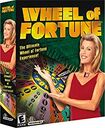
Released Wheel of Fortune 2003 on October 28, 2002 for PC. As with the Hasbro versions, the games were developed by Artech Entertainment, Ltd. With the exception of Vanna's appearance and the use of the Season 19 intro (complete with the opening quote and music from Seasons 15-17), it is graphically identical to Hasbro's 2nd Edition game for the PC. As Pat was seen in one of the clips used in the Season 19 intro, this is technically his first appearance in any home adaption of the show.
Atari (2003)

Released a single version for the PlayStation 2 (PS2) on November 11, 2003. It was a graphically enhanced port of the second PS1 version, complete with the same available game themes and a sample contestant exam. In this version, the Prizes do not change after each round.
Jakks Pacific (2005, 2007)
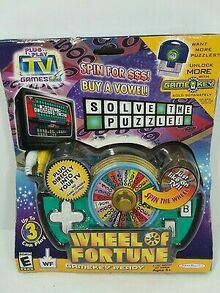
Released a controller in 2005 which plugs into a television and plays the game without the need of a console. The controller has a directional pad, A and B buttons (styled like puzzle board monitors displaying said letters), and a spinning Wheel with the 1999-2006 layout.
The Wheel can be spun using either the Wheel on the controller, or by pressing B. It can also be used to scroll through letters when entering a player's name before a game, or selecting letters during a game. If a player fails to spin the Wheel at least one full rotation in two attempts, the turn is forfeited. The Wheel used in-game is based on the 1999-2006 layout, except Lose A Turn is displayed as "Lose Turn", the yellow-orange $500 is $550, and a variant of the traditional logo is in the center.
In Round 1, a second regular-sized Bankrupt is used instead of the $10,000 Wedge (even though the Wheel was capable of landing on the left, middle, or right of any wedge as per the show). In the Jackpot Round (Round 2), the Jackpot increases by the amounts earned by players rather than the value of each spin. Interestingly, the Jackpot wedge also acts as a $500 space, a rule that the show would not adopt until the season after this game was first released. In the Mystery Round (introduced with the Prize Puzzle chimes), there is only one Mystery Wedge on the Wheel, though its prize is $15,000 in spendable cash. A "Gift Tag" (a blue circle labeled with a "P") and Free Spin (a dark green circle labeled with an "S") are available throughout the game, with a Prize wedge and second Free Spin added in Round 2. The Gift Tag and Free Spins are placed at random. Strangely, despite the controller using the $5,000 wedge, there is no Round 4.
Aside from the $100,000, the cash prizes available in the Bonus Round range from $25,000-$90,000. The Speed-Up bells sound anytime a player runs low on time for choosing an option, spinning, guessing a letter, or solving. The Bonus Round timer is used when attempting to solve a puzzle.
There are two different single-player modes: "Game Show" and "Endurance". The former limits the player to solving each puzzle without losing their turn a certain number of misses, identified as "turns" (4, 5, or 6, depending on the difficulty level), while the goal of the latter is to amass a high score by playing as many games as possible until running out of turns, which are not replenished at the start of a new round. Once the player runs out of turns, the puzzle solution is revealed with the chimes and the game ends. The player's score is the total accumulated from previous rounds up to that point.
The game supports up to three players, with no option for AI opponents. Due to the limitations of having only one controller, Toss-Ups are not done. Instead, for multiplayer games, order of play is determined by spinning the Wheel, with the highest value starting Round 1. Each subsequent round is started by whoever won the previous round. The colors used to identify the second and third players are blue and yellow, respectively.
In 2007, a second edition was released with a new controller unit. This version has the same design, though with a new color scheme and a few other minor differences, such as the removal of the directional pad. Instead, the player scrolls through options using the Wheel, which now spins both clockwise and counterclockwise. In the directional pad's place is a picture of the Free Spin and, despite not being in-game, the Wild Card.
The second edition features slightly updated graphics. Palm trees are added behind the puzzle board and the Wheel border is updated from the gold/blue style (used on the show from 1997-2003) to the current neon style. The Free Spin is changed to a plain, green circle with no text. The Wheel layout is the same, with the exception of the removal of the second Free Spin and Gift Tag.
Expansion packs featuring additional puzzles were planned for the first edition through Jakks Pacific's GameKey concept, a cartridge that could be inserted into a special slot in the controller, though never released. The GameKey slot was removed from the second edition's controller.
The packaging of each version shows the 1999-2006 Wheel layout (with the bolder font). The second edition was re-released in 2009 with the company's new box-style packaging scheme, which featured the Season 26 motif. Both versions of the game itself uses the 2000-06 theme, while the second edition uses the Season 24 logo with "2ND EDITION" in the SF Fortune Wheel font added below.
Sony Online Entertainment (2005, 2007-09)
Released Wheel of Fortune Deluxe for PC on December 30, 2005, followed by Wheel of Fortune 2 (an update of their 2003 online game) on April 1, 2007 and Wheel of Fortune Super Deluxe (a feature-identical update of Deluxe) on May 23, 2008. The 2005 game is the last to ignore $350. On these versions, the Jackpot wedge can be landed on only once per game. Also, if one of the Mystery wedges is picked up, the other is also removed from the Wheel.
A version was released for the PlayStation 3 on March 19, 2009; while being the first game to use the Million-Dollar Wedge and Season 26 rules, it has two major detriments: not only does it lack the Gift Tags, Prize wedges, Prize Puzzles and Speed-Up rounds (most likely because they weren't considered as necessary here as they were on the show), but a bug renders the Wild Card unusable unless the player buys a vowel that is in the puzzle.
Another noticeable element in early downloaded versions of the PS3 game is the simplicity of winning $1,000,000 in the Bonus Round: if the Million-Dollar Wedge is brought to the Bonus Round, the prize will always be the Million. On the other hand, if the wedge is picked up but not brought to the Bonus Round for any reason, the prize will always be $100,000.
Sony Mobile Entertainment (2005?)
Released Wheel of Fortune and Jeopardy! for mobile phones in 2005 and plays like the TV show, using MIDIs of the show music.
Around 2007, Sony released Wheel of Fortune Road Trip which plays similarly to its regular counterpart with a few differences. One, the player goes to major cities across the United States, with puzzles relating to the city that the player is in. Two, Bankrupt and Lose A Turn are renamed Out Of Gas and Flat Tire respectively. Three, a Road Trip token is added to the Wheel. Little is known about this element, but it appears to relate to letters the player chose throughout the trip.
Stern Pinball (2007)

A pinball game designed by Kevin O'Connor and Margaret Hudson was released in late 2007, featuring Pat and Charlie. The pinball machine featured a spinning Wheel with point values (which includes 750) multiplied by 100.
Irwin (2009)
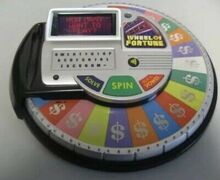
Released two "talking" electronic versions: Deluxe Edition and Platinum Edition. Each feature a Wheel with the current color template, but with dollar signs only. When the Wheel is spun, the Seasons 24-26 template scrolls upwards on the screen (and with gradual movements of the Wheel, can stop anywhere the player wishes). Each game also has a QWERTY keyboard that can only be used with the included touchpen.
As it follows the Season 26 rules, the Jackpot Wedge, Mystery Wedges, Wild Card, Prize wedge, Million-Dollar Wedge, Gift Tag, and Free Spin (shown as "Free Spin + $300" if the Wheel stops there) are present. When landed on, the dollar value underneath each "cardboard piece" is revealed on the display as the player chooses a letter.
Irwin's games are the only electronic LCD games to use the opening chant and current sound effects (minus the puzzle-solve cue), and also use the first few notes of the 2000 theme. Rather than Pat or Vanna, both editions are hosted entirely by the show's then announcer Charlie O'Donnell (the only games to have such a feature). The graphics and logo on both the packaging and the games are from Season 24.
Raw Thrills (2010, 2012)
In Summer 2010, Raw Thrills, in association with Konami and Play Mechanix, released another Wheel redemption game for arcades. The motif is based on that of Season 27, with various music cues from the show and gameplay using photos from the actual set.
The machine itself has a large, vertically-mounted Wheel displayed in front of where the player sits, similar to the Wheel of Fortune slot machines. Under the Wheel is a touch-sensitive monitor with a small "knob" underneath used for spinning the Wheel, similar to GameTek's arcade game. An optional feature is a stool the player sits on, which has a curved shape similar to a contestant podium from the show, and a blue cushion along the top in a fashion similar to the padded railing of the contestant area; the outer side of the stool bears the Season 27 logo. Sitting along the sides of the machine are two large cutouts of the basic Wheel template with the Season 27 logo over it, but with the top dollar value and penalty wedges replaced with cash wedges. A similar layout is printed on the "Spin" knob.
The game has two modes: a regular mode and a "Double Play" mode (accompanied by a graphic similar to the Double Play token), which doubles the value of all spins and costs twice as much to play. After inserting the desired amount of credits, the player chooses a mode, and the game opens with a shortened Season 27 opening animation. The player is then greeted by an announcer.
The puzzle and category are displayed. Depending on the number of letters in the puzzle, a few may already be revealed at this point. Punctuation is omitted, including from contractions (as was the case until about 1978), and all Same Name puzzles spell out AND. The player spins by turning the "Spin" knob and will get either one or three spins depending on the settings configured by staff. Spin power is displayed on a meter at the bottom of the screen: if the spin is too weak, the player must spin again; otherwise, the words "WATCH WHEEL" appear with two arrows pointing up (again, similar to the Wheel of Fortune slot machines). After the Wheel stops, the player is shown the value and a keyboard appears to choose a letter (although only letters that appear in the puzzle can be chosen). If the mode only allows one spin, the player chooses three letters; otherwise, the player spins three times, once for each letter. When a letter is chosen, all instances are revealed as a model walks across. Vowels are treated in the same fashion as consonants and will not cost the player if chosen. The player receives the value of the spin in tickets for each instance of the associated letter. After three letters are picked, the player must solve the puzzle. Depending on how much of the puzzle is already revealed, a bonus is awarded for a correct solve. When solving, if a wrong letter is typed, the player is buzzed and the puzzle is revealed. Even if the puzzle is not solved, the player still wins the tickets earned from guessing letters.
Like its TV counterpart, the Wheel has 24 wedges. There are multiple different layouts that can be used, all of which have different payouts. Each layout has an assigned cost required for playing the game. On the default layout, which assigns the game a cost of $1.00 for regular play, normal ticket values range from 2-10. There are also four "special" wedges, all located 90 degrees apart and split into thirds like the show's Million-Dollar Wedge. The outer two sections are white and only worth one ticket on all layouts (two at Dave & Buster's locations as tickets are distributed by two, thus not allowing odd-numbered payouts). The middle section is gold and is worth 20, 50, or 200 tickets. The Wheel layout with the highest payout assigns the game a cost of $3 for regular play. Normal ticket values range from 4-20 and the three top values are 100, 250, and 500.
Though the Wheel used in this game has no penalty wedges, the earliest known prototype of the game used four Bankrupts (plus two on the outer sections of the top ticket value instead of 1-ticket spaces) and two Lose A Turns (displayed on the "Spin" knob only on the earliest known playable demo {displayed at the 2010 European Amusement and Gaming Expo}, whose in-game Wheel replaced these with white 1-ticket spaces).
2012
A new model of the machine was released in 2012, which has a more compact design but retains the Season 27 motif and the option for the stool. While there are no gameplay changes, the biggest difference is that there is no longer a physical Wheel; rather, a computerized Wheel is displayed on the monitor, which is now larger, stands vertically, and is no longer touch-sensitive. Instead, players now scroll through options and letters using the knob (now referred to as a dial) and select with a large blue button.
Placed in numerous areas is a single, altered version of the Wheel layout used from Seasons 26 to 28, albeit with half the template (going clockwise, from the green $600 to the pink $900) used twice; as a result, no special spaces are present while one each of the green $300 and pink $900 are replaced by a purple $600 and pink $450, respectively. In place of the former touch screen is a lit outline of the two-row logo.
Facebook (2010-11, 2012-)
2010-11
The original adaptation consisted of one round and a Bonus Round. Gameplay used the Seasons 27-28 Round 1 template, albeit without any cardboard, and with the yellow $400 in place of Free Play. Four bonuses were available in limited amounts: Timeout, which paused the game for up to 30 seconds; Free Play, which functioned identically to the wedge; Reveal Letter, which revealed all instances of a random letter, starting with those that appear least frequently in the puzzle, without awarding money; and Double Bucks, which functioned identically to Double Play. Letters could be called by clicking on them or typing them, and the wheel was spun by either clicking "Spin" or hitting the space bar. If a player entered a letter that was already called, then the game simply did not respond.
The game was known to have a few minor glitches: Bankrupts were exceedingly rare, Lose A Turn never seemed to be hit unless a wrong letter had been called, and puzzles featuring hyphens would often create an extra blank space before the hyphen.
The game allowed up to five lost turns (not counting wrong letters from Free Play), with a 10-second timer for calling a letter. There was also a $1,000 house minimum if the player lost their fifth turn or solved for less than that amount. The Bonus Round offered the usual RSTLNE plus three more consonants and a vowel of the contestant's choice, with a 30-second timer and a $5,000 bonus if solved. Unsolved bonus puzzles could be submitted to a friend, which awarded $2,500 to both the friend and the original player if solved. In-game winnings were banked without an upper limit, and every $150,000 earned increased the level and awarded 75 Wheel Gold.
The game's difficulty fluctuated very wildly: the maingame would often range from puzzles similar to those on the actual show to ones as short as five letters, often with few to no common consonants (e.g. JEWEL in the category Proper Name). Meanwhile, the Bonus Round would range from being almost entirely composed of RSTLNE (e.g. STREET CORNER) to having none of those letters at all (e.g. AUDIOBOOK); it also used some unusually obscure answers (e.g. MOKA POT) and some as short as three letters (e.g. TMZ). At least one puzzle (WITCHITA KANSAS) is known to have been misspelled.
Returning every day earned an episode, an amount of gold (10 for one day, 20 for two days in a row, and 30 for three or more), and two spins of the Spin & Win, which involved spinning the Bonus Wheel to win a prize (either an episode, a bonus, or a random amount of Wheel Gold). Wheel Gold could be used to buy more episodes and/or any of the four bonuses, which could also be purchased with Facebook Credits. Daily bonuses for players (usually a free episode or amount of gold) were also posted on the game's wall.
Originally, money earned in-game could be used to purchase items in "collections" (individual wedges, letters, outfits, etc.). Each collection was unlocked upon completing five levels of the game, with a Wheel Gold bonus for purchasing an entire collection. There were five sets of collections: bronze, silver, gold, platinum, and diamond. Also, the amount of money needed to level up was made increasingly higher with each level. The collection aspect was retired, and the level-up amount fixed at $150,000 (with all players' levels retroactively adjusted to match), in May 2011 as a means of making the game easier.
Like the Wii/DS versions, this game used the categories Book Title and Classic Movies, neither of which are on the actual show. It also inconsistently referred to TV Title as TV Show Title, and sometimes used Family to indicate general names of family members (e.g. BROTHER & SISTER) instead of the names of famous people who are related to each other. It also used Slogan, which had long been retired on the actual game, although it did not ask for identification of the associated product (one example being MADE FROM THE BEST STUFF ON EARTH, the slogan of Snapple).
The game used the entire current opening theme on the title screen, as well as most of the current sound effect package. However, the "only vowels remain" beeps were also used if no more vowels remained in the puzzle, and the wrong-letter buzzer was used if the bonus puzzle did not contain RSTLNE and/or any of the letters guessed by the player. If the player hit Lose A Turn or Bankrupt, or failed to solve a puzzle, an "aww" track would sound.
2012-
The Facebook game was overhauled in August 2012, when it was merged into the Games by GSN collection. In this format, puzzles are now always two lines long and trophies can be unlocked for various activities (such as passing a certain number of games without hitting Bankrupt). The "collections" element is reinstated and made more relevant to the game, as unlocking certain collections now offers the ability to add $3,500, $5,000, Mystery, Jackpot, and Million-Dollar wedges to the Wheel. Also, the Bonus Round is now significantly easier, with RSTLNE always revealing approximately half to three-fourths of the puzzle.
While the "old" Facebook game could still be played for a time after its retirement, unsolved bonus puzzles could no longer be sent to friends, and the leader board and wall were no longer updated. Furthermore, it was announced on October 3, 2013 that the old version would be "moved" to the Games by GSN app on the 11th.
Wheel of Fortune Slots (2012-)
In late 2012, the Games by GSN app launched a "Wheel of Fortune Slots" game, a basic slots game that incorporates various elements of the show into its gameplay. The only online Wheel slots game not created by International Game Technology, "Wheel Slots" features six different varieties of "City Symbols" on its reels, which award a special prize (a dream vacation, an automobile, watercraft, or a luxury home) if the player gets three or more such symbols on any active pay line; as well as a bonus game called the "Money Wheel Game" where a player can spin the Wheel to win a prize of bonus tokens. Starting in 2014, the game has also been available in a "Vegas Edition" with enhanced graphics and more active paylines. In that edition, there are four different Bonus Rounds instead of one: the "Double Wheel Spin", which allows players to spin two wheels to earn their prize; the "Prize Envelopes" round, where a player can match three envelopes to earn bonus tokens; the "Sticky Wilds" game, which awards five Free Spins and has wild spaces stick in place as they appear; and the "Bonus Wheel" game, where the wheel awards multiple prizes per spin.
THQ/Nordic Games (2010, 2012)
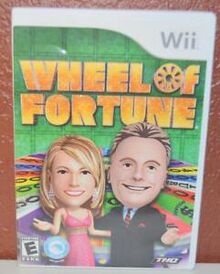
Released a version for the Wii and Nintendo DS on November 2, 2010. It is not only the first version to use the Gift Tags and Prize Puzzles, but it is also the first console version to feature Pat and the last game with Charlie, who died the day before.
The Wii avatars of Pat and Vanna were used in various openings (created by Pipeworks Software) during Season 28, in part to tie in with the then-new game; a few of these were reused as commercial bumpers in Season 29. Griptonite Games developed the DS version.
Interestingly, the Wii version is one of only three board or video game adaptations that are known to have been offered as a prize (the others being two of Pressman's 1980s games): on October 22, 2010, it was part of a $5,000 prize package which included a Wii and Sony TV.
The DS version has several oddities:
- The Prize Puzzle is exclusive to Round 1 and its trip and value is revealed before the puzzle (though it can be skipped).
- The $1,000 house minimum still applies for the Prize Puzzle, unless the player also wins the Jackpot.
- The Wild Card is forfeited if the player does not win the round in which they earn it.
- In multiplayer games, each player does each Toss-Up individually, with solve times compared after everyone has played it and the quickest being declared the winner.
- Because the Wheel is controlled solely by swiping it, it must make a full revolution in order to count, likely to prevent cheating by aiming. If the Wheel does not spin a full 360 degrees (even if the Wheel lands on the same wedge where it started but short of the actual position), it resets itself until a valid spin is done.
- Round 4 always begins as a Speed-Up. Combined with the above rule, it is impossible for the Final Spin to land on $5,000, as the Wheel starts with the red arrow on the orange $300 only two spaces left of $5,000, as per the show. Also, the Gift Tag and Wild Card remain on the Wheel, and Pat spins again if he lands on either.
The Wii game almost exactly matches Season 27's rules with only a few differences.
- Like in Sony Online Entertainment's games for the PC (as well as some international versions), both Mystery Wedges are removed from the Wheel whenever one of them is picked up.
- In Round 4, the yellow $400 used before Season 27 replaces Free Play.
- The Speed-Up always begins after three turns are completed in Round 4, whether or not any or all of those turns were lost.
- Whenever the Bonus puzzle is solved, a bug adds the player's final total to whatever s/he accumulated in the Speed-Up round regardless of whether or not s/he solved the Speed-Up puzzle, the game's only major oddity.
2012
A newer version (referred to as Wheel of Fortune 2 by the company) was released on October 16, 2012 for the Xbox 360 and PlayStation 3 (not to be confused with the 2009 Sony Online Entertainment version), followed by a Wii U version on December 14. Modeled after Season 29, these games have the current generic set and are the first to use the ½ Car tags; however, it still uses the Seasons 27-28 Wheel with the green $700 and the Wild Card still on that wedge, moving one of the ½ Car tags to the adjacent $450. Additionally, it still offers $25,000 as a possible bonus prize despite it being retired at the beginning of Season 28.
Unlike the Wii and DS versions, the 2012 games have online multiplayer, online leaderboards, and additional puzzles available for download. Interestingly, among the in-game unlockables are the aforementioned Pipeworks intros.
Achievements/Trophies are awarded for doing various things, such as hitting Bankrupt with a Prize wedge, Gift Tag, or ½ Car tag; winning the Jackpot; solving all three Toss-Ups; winning a car; winning the Million; and solving a puzzle with one letter showing (called "I've Got A Good Feeling About This!" [the Xbox 360 achievement accidentally omits "Got"], a direct reference to Caitlin Burke's famous puzzle in November 2010, just three days after the release of the Wii and DS versions).
Also present in the game are Pat voiceovers for quite a few unused items. These include a variety of categories (including eight "bonus" categories and Where Are We Going?, which is on the official category list despite never being used) and Wheel values (including $275 and $2,000, both long retired, plus the nonexistent $475).
A "Retro 1980s" set theme was released in early 2013 as DLC for both the PS3 and 360 versions. Unfortunately, every element is "off" to some degree:
- While using elements of the mid-1980s set, the studio itself remains at its normal size, resulting in large gaps between the puzzle board, turntable, and Wheel.
- The puzzle board replaces the neon border with the 1981-94 border, although the lights do not flash or chase and simply turn green when a puzzle is solved; some outros will show it turning off certain lights in a very similar manner to the original chase light sequence, as will solving the bonus puzzle. Unlike the iOS game below, the monitors are not replaced by trilons despite the "bars" for said trilons being present.
- Stretching all around the set is a single wall ostensibly meant to resemble the 1984-86 host backdrop, although it has no "ridges".
- The turntable has black walls, sharp-edged corners, and no lights on the edges. Two of the three sides represent a living room and bedroom, while the third has a car and some potted plants. The turntable also rotates continuously throughout the game, albeit counterclockwise rather than the clockwise of the show itself.
- The spiral pillars flanking the turntable are much thinner, with fewer lights.
- The contestant backdrops are the sunbursts with rings, although the latter set are ribbed much like the puzzle board's border. The sunbursts themselves are clearly their second design (1984-86), although the "spikes" have an even, consistent pattern that was not present until their third design.
- The Wheel has its light rings and classic style of lights surrounding the Wheel itself, although the former lights act as they do on the modern set whereas the latter lights do not flash in sync with the Wheel's spinning.
Wii U differences
The Wii U version initially retailed for $50 ($20 more than the 360 and PS3 versions), and is generally of a lower quality than the other two games due to the following:
- Most notably, there is no online play or Mii compatibility, despite the former being plugged in promos and on the game box. The menus remove the Leaderboards option, leaving a noticeable gap.
- There are no player profiles, whereas the 360 and PS3 versions use the player's online username for the in-game name. As a result, the player can only be listed as "Player 1".
- For multiplayer games, the second and third players must use the default avatars with no customization available. Also, only one player is able to use the GamePad.
- Despite not being mentioned on the box, Wii Remotes are required for multiplayer. The controls are similar to the 2010 game, except A can be pressed to spin. The motion controls remove the necessity of holding B, however the spin strength goes by the power meter rather than the strength of the motion itself. The button used to lock in a solve is also changed from 1 to 2, although it is displayed as X (the button used by the GamePad).
- The GamePad itself has very little purpose, other than selecting letters and options by tapping them on the screen; further, swiping the touch screen does not spin the Wheel but rather stops the power meter from moving. While the GamePad shows the same image as the TV, the audio comes solely from the TV speakers, rendering GamePad-only play silent.
- Another yellow $400 replaces Free Play in Rounds 4+, which was also the case in the Wii version as well as the 360 and PS3 versions.
These oddities echo those of GameTek's last Wheel game 15 years earlier, albeit on a far larger scale, and was very likely released on a Christmas deadline. Unlike GameTek, which filed for bankruptcy seven months later, THQ filed for bankruptcy a mere five days after this version was released. In April 2013, the Wheel and Jeopardy! licenses were bought (among many others) by Nordic Games, which has since re-released the 2012 games under their name and with new box art.
iOS/Android (2012-)
The 2012 game was released alongside THQ's games, although it does not feature Vanna or any voice clips (however, Pat and all computer-controlled characters communicate through speech bubbles) and is closer to being a "Decades"-style game. Unlike its contemporary console brethren, it is the first game to use the Season 30 Wheel layout, making this only the second game to use $650 as a playable value, after the 1992 Game Gear version. Amusingly, and appropriately, the in-game shop uses the 1983-89 turntable.
Most notably, there are five different sets, each unlocked by winning five games on the previous set, which Pat gives a brief introduction to. Despite this, all sets use the same rules, sounds, Wheel layouts, and music.
- Today - The then-current (Season 30) generic set.
- Millennium - More specifically, Season 20 (2002-03), with the "20th Anniversary" logo and 1997-2003 puzzle board.
- Nineties - Most likely intended to be early Season 14 (late 1996), with the 1992-96 contestant backdrops and 1995-97 puzzle board. This and the next two sets replace the digital score displays with an accurate Eggcrate style based on the 1988-90 road-show displays (which is also seen on the Millennium set), and use trilons for the puzzle board. Interestingly, Vanna's absence means the puzzle board is automated, which had been Ed Flesh's intent when he designed the three-line board in 1974.
- Eighties - More specifically, the Radio City Music Hall shows of November 1988, with the road-show diamond backdrops (1988-95) and puzzle board (1988-97).
- Premiere - Intended to represent the 1983 nighttime debut, although the set pieces (1981-94 puzzle board, 1977-89 curtain, and original sunburst backdrops) coexisted from 1981-84 before the sunbursts were changed to their second design shortly into Season 2. Strangely, the sunbursts have gold "beams" instead of white and are simply decorations, with no hint of the "ON ACCOUNT" displays.
Also, Pat's appearance (wardrobe, hairstyle, etc.) changes with each unlocked set.
As with the 2009 PS3 game, there are no Gift Tags, Prize wedges, Prize Puzzles, or ½ Car tags. Unlike that version, however, there is a Speed-Up round unless Round 4 is solved rather quickly (although the Final Spin usually occurs after about two or three turns are lost). Additionally, the Wild Card is an option along with spinning, solving, and buying vowels, as it was on the Wii, DS, Wii U, 360, and 2012 PS3 versions.
2013
Wheel of Fortune: Cubed, a unique variation which turns the puzzle board into a 5×5 word cube and hence creating thousands of word combinations, was released on July 11, 2013 for iOS only at a cost of $0.99. Players can race against the clock in a single-player mode called "Cube Rush", or challenge their friends via Facebook or email (or a randomly-selected opponent) to spin the Wheel and solve the cube.
Players can use Cube Coins for special powerups, and share their scores on Facebook via the Game Center leaderboards. The game can be played on any compatible device after it is purchased, while additional content can be bought through an in-game shop.
The Wheel layout is also the same as the Season 30 layout, albeit with the yellow $400 in place of Free Play. In Cube Rush mode, however, the penalty spaces are all $300 wedges despite one of them being next to another $300 space. Also, a silver $1,000 space is in the place of where the top dollar value would be.
2014-16
On August 14, 2014, Scopely released a beta version of their own game, for Canadian (later British) test audiences with Android phones only. Eventually titled Wheel of Fortune: Free Play, the game was released on Android and iOS for American test audiences on October 19, 2015 and closed on November 12. On September 21, 2016, the game was released in the United States for all audiences.
The game features World Tour mode which offers puzzle themes and prizes from cities across the globe. The Wheel seen in the icon and splash screen is the same as the Season 31 Round 4 layout only in Clarendon font with a yellow $400 in place of Free Play and a Bankrupt in the place of the top dollar value wedge, with the wedge to its left being the purple $600 from Season 26. A second icon was released with various Season 32 cash wedges popping out.
Like most of Scopely's other titles, two human players play against each other in an effort to solve a puzzle in a fewer amount of turns. This title will also have a three-player segment in World Tour where the human plays against two computer opponents (albeit represented by actual players). In order to advance, players need to win a specific amount of cash and collect souvenirs. Each stage offers bigger Wheel values, some of which were never used on the show such as $3,000, $4,000, and even $950, making this only the second game to use $950 as a playable value after the 1991 game for the PC.
There is also a tournament mode (unlocked at level 6) where players with the highest scores receive diamonds which are used to purchase in-game content.
Vanna's Showcase is a feature where players can unlock various power-ups including protection from penalty wedges and the ability to increase certain cash wedges. To do this, players must land on a Prize space (the Prize is shaped like a Gift Tag) and call a correct letter.
Wheel Clubs have been added to the game as well. Interestingly, the Wheel Club's background music is a mellow take on the show's 1989-92 theme.
Gameplay for World Tour and tournaments is similar to the show only one spin and/or one vowel is/are allowed per turn. After this, the player must pass if s/he does not know the puzzle solution.
Several elements have been planned for the game such as the Express wedge, which would have made this the first game to include it, but have yet to make an appearance in the game. The now-retired Surprise wedge, however, returns in this title although it functions similarly to the Mystery Wedges. When landed on, it can reveal a large cash value that can be multiplied by how many letters appear in the puzzle, a Free Play, or a Bankrupt.
Other elements that have never appeared on the show or perhaps even existed in the franchise are also included as well as planned to be included. One element currently in existence in the game is a red wedge called Multiply. When a player calls a correct letter, his/her round score is multiplied by how many letters are in the puzzle. The total is then added to his/her round score.
Wheel of Fortune Puzzle POP
On June 23, 2016, Sony Pictures Television released Wheel of Fortune Puzzle POP for iOS and Android in the United States after having released it in other countries. The game is based off of Taito's popular game Bust-a-Move (a.k.a. Puzzle Bobble) where the object is to clear a stack of bubbles at the top of the screen via bubbles shot from the bottom.
In Puzzle POP, the object is to solve word puzzles via bubbles that have letters on them. A Wheel can be spun to provide the players with power-ups. The game stars Vanna, who appears in caricatured form in exotic tropical settings, and after solving the first few puzzles, the player unlocks her cat Stella, who cameos to swap out bubbles in the basket. As players progress, they can play levels where they can earn hidden treasures for huge rewards. Occasionally there are also weekly challenges and cruise ship events where players can solve special themed puzzles to win prizes. The word puzzles in the game were prepared by those involved in writing for the actual show.
Ubisoft (2017)
America's Greatest Game Shows: Wheel of Fortune & Jeopardy! was released for the PlayStation 4 and Xbox One on November 7, 2017 and for the Nintendo Switch on October 30, 2018. The games can be purchased together in retail stores for $40 or separately online through the PlayStation Store or Xbox Games Store for $20.
The Wheel of Fortune game is the first to feature the Express wedge and even has an achievement for completing a successful Express run for the first time.
Interestingly, instead of Pat and Vanna, the game has a generic host and hostess, a nod to Sharedata's games for the PC and GameTek's first three games for the NES. This is because Ubisoft refused to give them more money in exchange for their likeness and voices being used in the game; there was also a 2016–17 video game voice actor strike started by the Screen Actors Guild‐American Federation of Television and Radio Artists (SAG-AFTRA) union against 11 American video game developers and publishers. Jim Thornton is still the announcer, however.
The gameplay is the same as Season 34 with a few differences.
- There are no Crossword-themed puzzles.
- The Prize wedges and Prize Puzzles are all worth $7,320. The player can choose which Prize wedges and Gift Tags (which are for fictional companies rather than real ones, possibly to avoid Ubisoft paying residual fees) s/he wants on the Wheel.
- The car, offered through both the 1/2 Car Tags and the Bonus Round, is valued at $46,840, making it extremely difficult for an opponent to win the main game if a player wins the car via the 1/2 Car Tags.
- If a player picks up the Mystery Wedge containing the $10,000 prize, s/he does not give back the $1,000 per consonant that s/he earned.
- The Prize Puzzles are not always related to the Prize.
- The current music package is used, but the previous solve cue is used when a contestant gets at least $5,000 from calling a correct consonant or picking up the Prize wedge or Gift Tag. A different piece of music is still used whenever the contestant scores less than $5,000 for a correct letter. Casino-style music is played throughout the game.
- The Bankrupt slide whistle is used when someone lands on Bankrupt and Lose A Turn, just like the games for the PlayStation 1.
- The buzzer used on the show is not used. Instead, a different buzzer is used when a player takes too long to make a decision (although it was also used for an incorrect attempt at solving before an update patch was released). No sound effects are used when a player calls an incorrect letter.
- As with the Nintendo DS version, Round 4 always starts as a Speed-Up.
- The Million Dollar wedge is not surrendered if the player in possession of it does not solve the puzzle the round it is picked up, but it can still be lost to a Bankrupt.
- The music used when a player tries to solve the Bonus Round puzzle is the same one used in the Speed-Up.
Canceled Versions
While a great many versions were released, several were not. Unless otherwise noted, no prototypes are known to exist, although the Admins invite anything saying otherwise.
The Great Game Company (1983)
"We've Got The Great Game Ideas"
While the first Wheel video game was released in 1987, it was not the first attempt. In September 1982, one was touted for the Atari 2600 (a console offered at times on the show) and Mattel Intellivision alongside Family Feud, Jeopardy!, The Joker's Wild, Password Plus, The Price Is Right, and Tic-Tac-Dough. Two of these were scheduled to appear at the New York City Toy Fair in March 1983, with Michael Sisson in charge of graphics design and Patrick McBride in charge of programming. The Great Game Company (GGC)'s press kit (second link) claimed that the Atari versions would be ready by Spring.
It is not known whether GGC appeared at the Toy Fair, but at least Feud got far enough for a prototype, as the June 1983 issue of Video Games Magazine had an article about the company (albeit with no pictures). McBride's main concern was trying to faithfully adapt the shows with the cartridge's 8K memory; the results, according to Sisson, were "superb":
"with up to 60 game rounds per cart and full use of the music, background and individual trade- marks of the particular shows. For instance, Family Feud [...] begins with an opening screen featuring the show's logo lights and an emcee walking out and planting a big KISS on the TV screen. The next screen offers a topic, say "Dangerous Fish," and the first player or team to hit the fire button of the joystick gets control of the board. Seven answers are displayed on the screen, with only the first letter of each revealed. The object is to find the three most popular answers on the board by moving a cursor, via joystick, to your guess within three seconds."
Goodson-Todman was directly involved in the Feud game's development, and it is very likely that Barry-Enright and Merv Griffin did the same with their properties. The packaging was simple but distinctive, with the show's logo in gold on a "silver black" background, and it was in this manner that this ad from GGC's press kit (first link) showed all seven logos, albeit overlapping. (The Jeopardy logo is an odd "interim" style used from about 1979-84 for at least Milton Bradley's Fourteenth Edition board game and a version for the same company's OMNI game console, both of which had the logo accompanied by a set of three question marks. An exclamation point-less version of the 1964-75 logo was used in "Weird Al" Yankovic's 1984 "I Lost On Jeopardy" music video, although this may have been to avoid trademark issues.)
Despite this progress, GGC became a victim of what has become known as "The Great Video Game Crash of 1983", the result of an overabundance of game makers and consoles with little in the way of quality control (the end result of Atari losing its court case against Activision), distinction between consoles (although each had a unique style that is easy to discern today), or third-party assistance to consumers as to what was good or bad – many game makers, including GGC, shut down as stores relegated consoles, games, and accessories to the clearance section in an attempt to remove inventory and get something back on investments that could not be returned to companies which no longer existed; games that had initially been priced at $15-$60 were now $5 at the most, while consoles that initially cost $250 or more were now around $50. As a result, focus tended to shift towards the home-computer market.
IJE, which owned GGC, retained the rights and licensed them to Sharedata in 1986 (a year after Nintendo's NES had resuscitated the American video game market). The resulting success prompted IJE to try publishing game show titles again, resulting in a name change...to GameTek.
Philips Interactive Media (1993)
Wheel was planned for the CD-i alongside The Price is Right, Jeopardy!, Name That Tune, The Joker's Wild, The Joker's Wild Jr., and Lingo. All were released except Wheel and Price, although Lingo was exclusive to European territories.
Charlie handled announcing duties on Jeopardy! (hosted by Alex Trebek) and both Joker games (hosted by Wink Martindale and Marc Summers, respectively). Tune, based on an unsold Peter Allen pilot, was hosted by Bob Goen.
GameTek (1996)
Adaptations were planned for the Sega Saturn and Panasonic 3DO to be released October 1, but this ended up being pushed back; they were announced to be "coming soon" by Charlie at the end of at least the December 18 episode, but no traces of either version appear to exist. A comment on gaming blog Joystiq claimed to have done Quality Assurance for Wheel, Jeopardy!, and Family Feud (the last of which was released for 3DO in 1994).
Based on the timeframe, they would have likely been the only iterations to use the 1995-97 puzzle board and may have used Double Play as well. The timeframe also suggests that GameTek's dwindling resources resulted in their cancellation, although this was not the first time the company scrapped a title (NES versions of (Talking) Super Password and The Price Is Right were planned for release circa 1989). Poor sales of both systems and the fact that the Saturn was a difficult platform to make games for may have also played a role in their cancellation.
Majesco (Late 1990s/Early 2000s)
According to IGN, Majesco is said to have made plans for a game for Nintendo's Game Boy Color, but if this was true, the plans were scrapped before development could begin.
Tiger Electronics/Parker Brothers/Hasbro (2004)
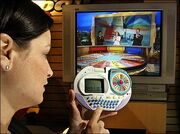
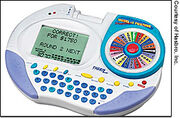
Promo shot of the prototype.
Teamed with VEIL Wireless Technologies to make Wheel of Fortune Live Play, which let viewers play along with the show much like the 1988 Mattel game, which VEIL also helped develop. While a "LivePlay" logo appeared during the intro of the Season 22 premiere, the game (with a proposed Holiday 2004 release date) was never officially released due to either technical issues, a possible financial situation at Tiger Electronics (as they released no Wheel games since then), or both.
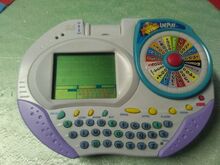
A photo of the copy sold in 2019. Note the differences between this copy and the prototype shown above.
Even so, a single unit was sold on eBay in December 2006, although it was packaged with a Parker Brothers logo, making it unlikely that it was a prototype. In November 2017, another packaged copy, also under the Parker Brothers label, was shown on display in New York City when the Paley Center hosted the show's 35th Anniversary celebration. In late December 2019, yet another copy, this time unpackaged, was sold to a fan on eBay. These three copies, along with various recollections of seeing the game in stores, seem to confirm that a very small number of units had been released by Hasbro under the Parker Brothers label in the United States.
It is not known if the prototype or the surfaced copies are compatible with the Season 22 premiere.
The prototype's 20-wedge Wheel (modeled after the Season 21 layout) is interesting in several ways:
- Some of the values have shifted positions by one space like the prototype of the 1999 Deluxe Edition, resulting in irregular colors for some values (such as a lavender $800 and bright yellow $550). In addition, instead of being colored pink and teal respectively, $450 and $700 are colored blue and yellow, somewhat reminiscent of how they were colored on the show ten years earlier.
- Free Spin is a full green wedge with "Free Spin" spelled out vertically (like in the 1995 game as opposed to the "horizontal Free, vertical Spin" used from 1974-89) in white letters. In addition, the word "Free" is abnormally large while the word "Spin" is rather compressed.
- $5,000 and $10,000 are colored irregularly: the former is pink while the latter is lavender. Furthermore, the font of the $10,000 space is the same style as the other cash spaces while $5,000 has its own font that is similar to that of the Free Spin space.
The copy sold in 2019 confirms that none of the aspects were changed apart from that the wedge colors, most notably the blue ones, were significantly brightened and that the entire layout was rotated by one space clockwise. It also confirmed that upon pressing a red button marked "SPIN" at the Wheel's center, a light would travel clockwise along a white ring bordering the Wheel, continuously changing colors as it did so (red for the penalty wedges and yellow and lime green for the others), before slowing to a stop. It also confirmed that neither "Changing Keys" nor "Happy Wheels" were used as the theme music. Rather, a generic game show-style theme was used, although it hinted some resemblance to Changing Keys. In 2012, the fan who would later buy the 2019 copy drew this impression as a guess of how the game may have worked.
The game offers a normal mode as well as a Live Play mode via a dial at the top of the game. The normal mode is similar to Tiger's other handheld games with a few differences. Every game starts with the light above the red $400 clockwise of Free Spin. $5,000 is the top value for the first two rounds while $10,000 becomes active in Round 3. Since $10,000 in a large font is displayed upon being awarded, the $10,000 space is believed to be active until a correct letter is called on it, similar to Tiger's Deluxe and Crossword games, but is confirmed to be multiplied by the number of letters in the puzzle. When Free Spin (active only in the first two rounds) is landed on, the green light above it flashes several times and an in-game host says, "Free Spin." The contestant then chooses a letter for the Free Spin yet no money, similar to most of Tiger's previous adaptions. When Lose A Turn is landed on, an in-game audience makes a short but sharp groan. When Bankrupt is landed on, instead of the slide whistle sound effect, the sound of coins dropping is heard. When solving, the player solves letter by letter rather than blank by blank, somewhat similar to the Express wedge. If a player puts in an incorrect letter while attempting to solve, any letters put in while solving prior to the error would remain in the puzzle while the player lost his/her turn, but s/he would not lose his/her winnings or be eliminated from the round. The Bonus Round still uses the W-H-E-E-L format with a top prize of $25,000. Gameplay videos can be watched here and here.
MGA Entertainment (2008)
Acquired the rights to make DVD games of Wheel and Jeopardy! in 2006. Jeopardy! was released in Spring 2007, with Wheel planned as a follow-up for early 2008; Wheel was shelved after the CGI set was completed, but before programming began, due to "numerous converging factors". The CGI set can be seen here, under "Directing".
Standalone discs with additional content were also planned for both games, although the Jeopardy! ones were never released.
Sony Online Entertainment (2010)
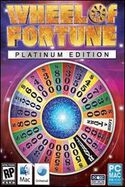
Platinum Edition was slated for release in January 2010 and was available for pre-order at various online retailers (including Amazon). In the end, however, neither the game nor any screenshots were released, leaving the box art (right) as the only evidence of its existence.
1999 Tiger Wheel of Fortune Deluxe Edition Video Game Instructions
Source: https://wheeloffortunehistory.fandom.com/wiki/Video_games
0 Response to "1999 Tiger Wheel of Fortune Deluxe Edition Video Game Instructions"
Post a Comment